Bebop, or the innovative musical revolution of the 1940’s led by Charlie Parker and Dizzy Gillespie, is one of the pillars of learning to improvise as a modern musician.
…and it’s something that every serious player should spend some time studying.
Chances are you’ve heard of Bird & Diz and the contribution of players like Bud Powell and Fats Navarro. And you’ve probably even encountered tunes like Donna Lee or Confirmation in your practice or at jam sessions…
However, truly understanding the essence of bebop and integrating it into your playing requires more than memorizing a few patterns and scales.
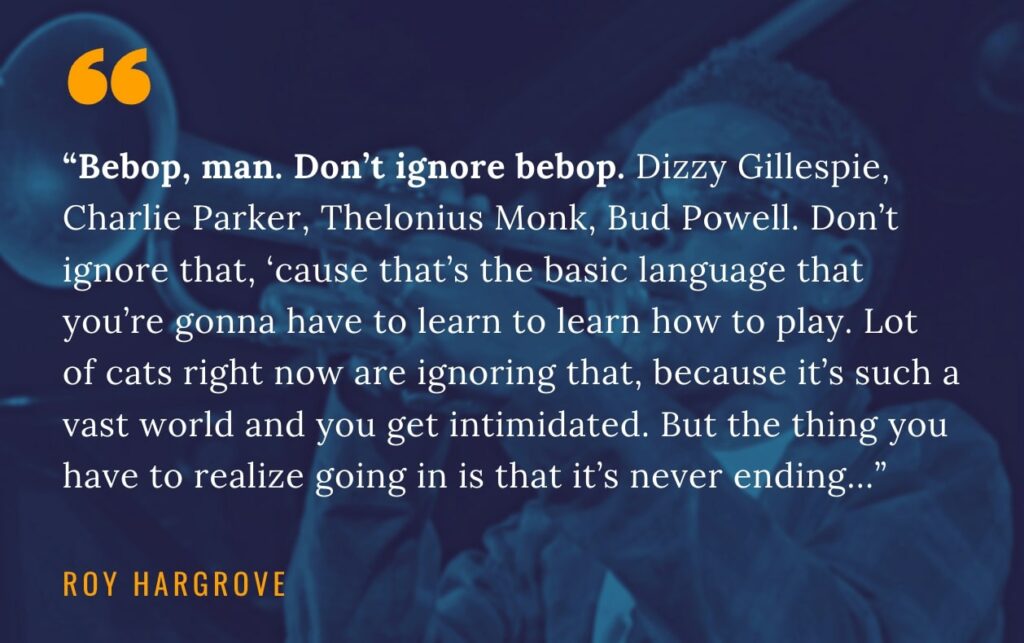
The truth is, you don’t have to exclusively perform bebop tunes or consider yourself a “bebop player” to play this music, but if you want to operate in a “modern” jazz setting and speak the music with an authentic voice, you do need to master the components of bebop.
In fact, elements of bebop are found in the music of Miles Davis, Joe Henderson, Kenny Garrett, Roy Hargrove, and scores of other musical masters.
If you want to improvise flowing melodic lines, utilize harmony in a modern way, or approach tunes with creative rhythms and phrasing – you need to study and eventually master the elements of bebop.
The goal of this lesson is to build a base repertoire and knowledge of bebop tunes that cover the gamut from Blues, Rhythm Changes, and other standard forms that utilize the common components of major & minor harmony.
Building your foundation
It’s important to remember that the bebop language was developed over the standard repertoire of the great American songbook, and that all of the progenitors of bebop learned and mastered the popular songs and repertoire of the day.
…in fact, players like Charlie Parker were already applying these ideas in their solos over these popular tunes!
To get the most out of each tune below, it’s vital that you understand and master the building blocks of this music before jumping into the innovations of bebop.
Specifically, this means knowing basic harmonic function in major and minor keys, common chord elements in the jazz repertoire, a knowledge of important song forms and standards, and some basic jazz language and ear training.
..this is the foundation on top of which bebop is built. Our Jazz Theory Unlocked Course is a great way to fill in the gaps and master the essentials.

Armed with a working knowledge of ii-V’s, cycle movement, and other important elements of jazz harmony, learning and conceptualizing these tunes will be much easier.
It’s more than the notes and chords
Another pitfall in learning jazz improvisation is the tendency to reduce songs, musical styles, and solos down to music theory…a scale for each chord, a theory approach to every progression, patterns, pentatonics, etc.
This often leaves out one vital aspect of the music – rhythm.
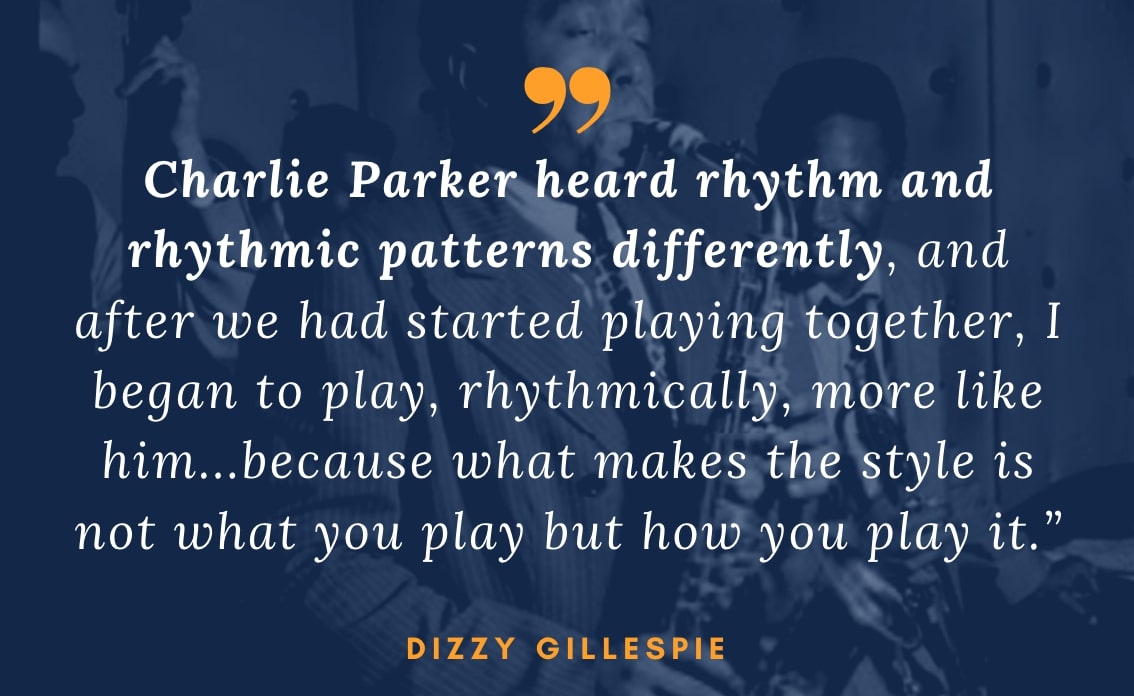
The rhythmic and phrasing innovations of bebop were just as vital as the harmonic ones. The trick in studying these tunes and breaking them down is to remember to approach them as music – not only as notes, chords, or theory to memorize.
To see what I mean, listen to how Charlie Parker plays the opening of his solo on KoKo:

The way Parker articulates or accents these notes and swings is an essential part of every phrase he plays, even more so than the particular tones. A great exercise is to focus on the rhythmic aspect of his lines alone:

Phrasing
The concept of creating musical phrases and placing them within a song form is important to any player’s style, and especially so for the soloists of the bebop era.
When you begin to improvise, it’s easy to fall into the trap of thinking of each chord as its own entity. You might even start every musical idea on beat one, a “boxy” approach to a chord progression, letting each chord dictating when to start and stop your lines:

But as you’ll see and hear in the tunes below, there is a freedom in the approach to phrasing – ideas stretching across bar lines, phrases starting on up beats, anticipating chords, etc.

Keep these rhythmic & phrasing ideas in mind as you listen to and learn each tune below, eventually absorbing these techniques into your own musical approach.
30 Bebop Tunes to Learn

The best way to learn the details of this music isn’t from etudes, theory devices, or patterns – it is directly from the tunes and solos of the masters that played it – in a musical, rhythmic, and harmonic context.
However, transcribing and learning bebop solos can often be a daunting or overwhelming task, especially when you’re first starting out...
That’s why in this lesson we’re going to focus specifically on the compositions written by the masters of this music, the repertoire of bebop tunes you’ll often encounter as a jazz musician.
Below we’ll walk you through 30 essential Bebop tunes to learn, divided by beginner, intermediate, and advanced level.
Now these tunes are not easy or hard per se, rather they are sorted in groups of growing complexity – the beginner tunes more accessible when you’re starting out. After all, these are tunes you’ll be working on for the duration of your musical journey.
Furthermore, we’ve broken down each section into categories which will make them easier to conceptualize and learn…
- Blues tunes
- Rhythm Changes tunes
- Contrafacts (tunes written over standards)
- Original compositions
The goal is not just to memorize the notes of the tune and move to the next one, but to spend focused time to learn and ingrain it – to identify important melodic and harmonic characteristics and absorb them into your musical approach.
Studying these tunes will give you a methodology, framework, and set of guidelines for approaching the chords, progressions, and melodies of the jazz repertoire…a “how-to” of soloing over standards, creating melodies, and finding new avenues of expression.
Think of this as a practice resource that you can return to as you listen, learn, and add these tunes to your repertoire. Below is a “table of contents” for each section that you can navigate to as you return to expand your practice:
Part I: Beginner Bebop Tunes
- Billie’s Bounce
- Au Privave
- Steeplechase
- Red Cross
- Crazeology
- Ornitholgy
- Scrapple from the Apple
- Yardbird Suite
- Confirmation
- A Night in Tunisia
Part II: Intermediate Bebop Tunes
- Relaxin’ at Camarillo
- Blues for Alice
- Anthropology
- Dexterity
- Moose the Mooche
- Bouncin’ with Bud
- Groovin’ High
- Nostalgia
- Quasimodo
- Segment/Diverse
Part III: Advanced Bebop Tunes
- Laird Baird
- Dance of the Infidels
- Shaw Nuff
- Wail
- Donna Lee
- Hot House
- Bebop
- Dewey Square
- Ray’s Idea
- Boperation
*Not every bebop tune is contained in this list, but with this core group of tunes you will have a solid repertoire to perform with and a harmonic and melodic foundation that will allow you to learn other tunes quickly and with ease.
I. Beginner Bebop Tunes
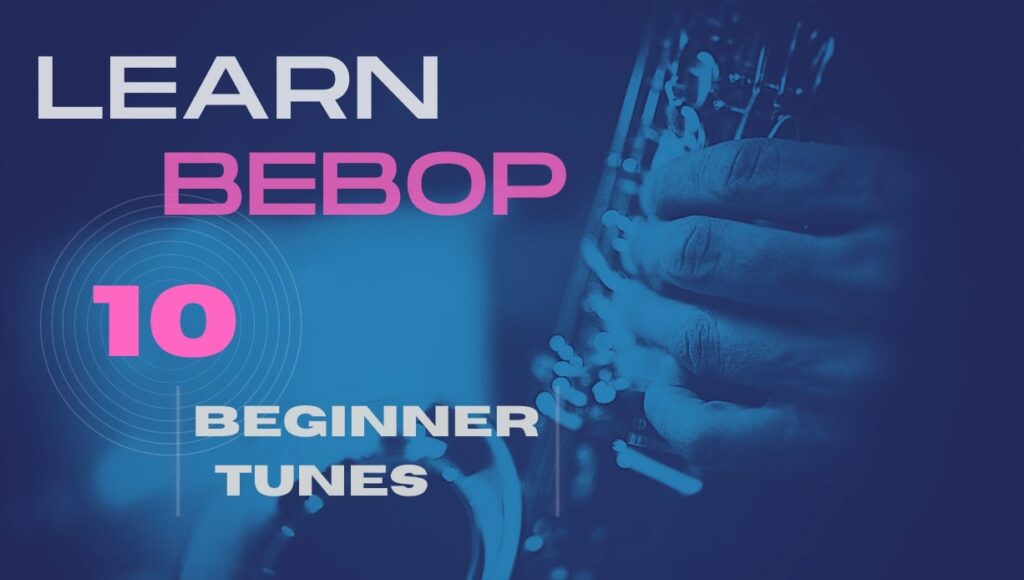
We’ll begin with 10 tunes that are a great introduction to the bebop tradition…
Your goal here is to slowly learn each tune, absorb the bebop language, and add these musical elements to your technique. Along with the notes, focus on stylistic details like the time, articulation, phrasing, and harmonic alterations.
An effective way to do this is with a simple 3 step approach to your learning process:
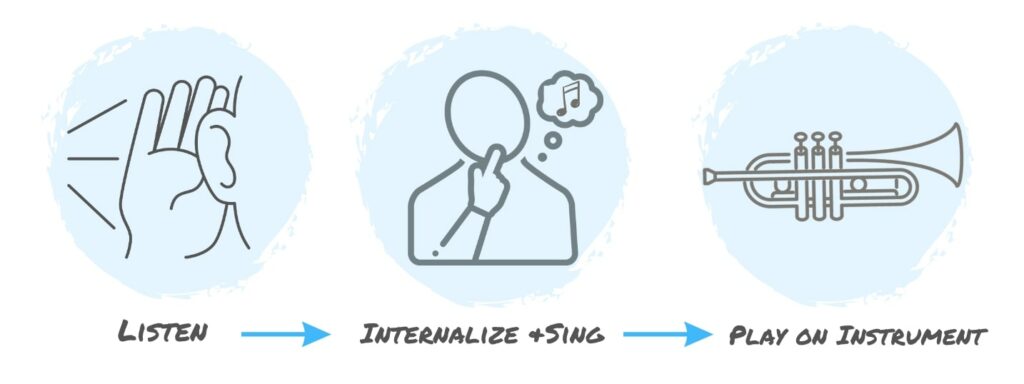
Use the notated musical examples as a check for what you’re hearing and to conceptualize the harmony and phrasing, rather than the only way you’re learning the notes!
Remember, the real tune is the music itself, the sound and feeling. The notation and harmonic & melodic tips are provided to help you make sense of what you’re hearing.
The best way to learn the musical details of each tune is by ear…and this means making sure your ears are up to speed. Check out the Ear Training Method to build your skills today:

Practice each tune slowly, working it up to speed, and finally trying to play it along with the recording.
Blues
A great place to start learning bebop is with a familiar setting like the Blues and Rhythm Changes – two perennial forms that you’ll encounter as an improviser.
The nice thing is, many of the bebop tunes that are in the standard repertoire (especially from Charlie Parker) are based on blues and rhythm changes…
With this in mind, we’ll start our bebop journey with the blues. You’ll be most successful in your practice if you begin with an understanding of the form and have some basic vocabulary before you jump into these bebop heads.
Here are a few lessons on the Blues to check out to build your knowledge:
With the form, tradition/history, and language of the Blues ingrained, approaching these bebop heads will make a lot more sense. Let’s get started…
1. Billie’s Bounce
Charlie Parker’s tune Billie’s Bounce is a well known jazz standard, showcasing some key bebop elements while retaining the essence of the blues.
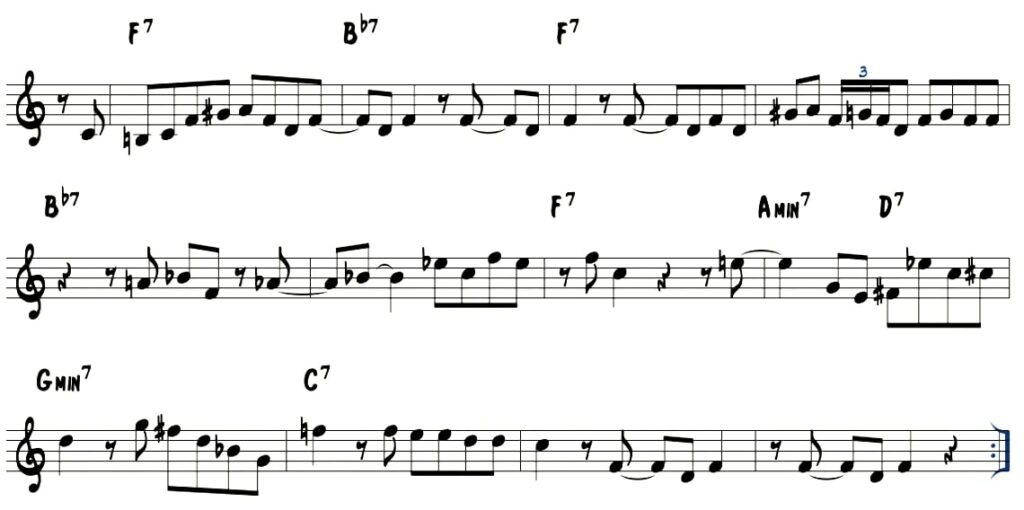
An effective way to learn this tune is through the phrasing structure of the melody – approaching the blues in 3 sections while learning valuable bebop vocabulary at the same time:
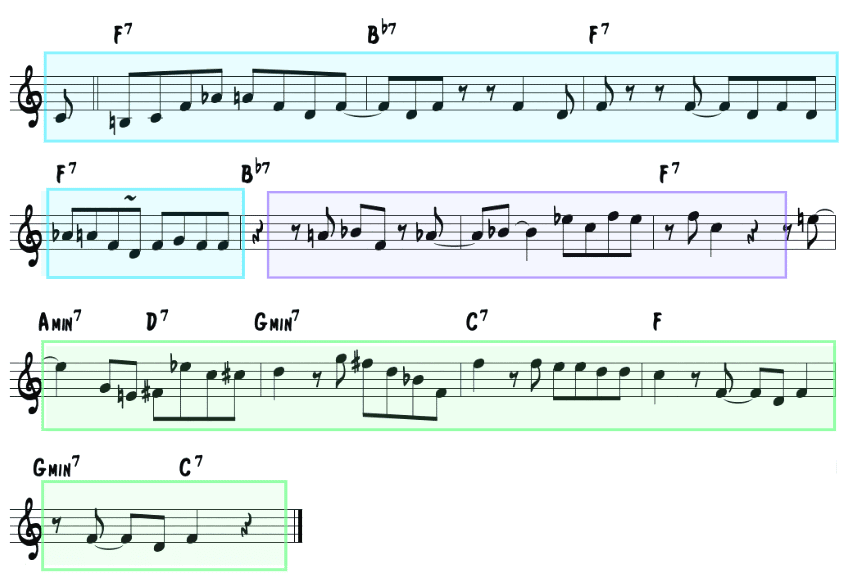
Parker plays one phrase over the I chord, another on the IV chord, and the final one on the turnaround and ii-V back to I.
You can use this simplified structure to create your musical phrases and develop your solo – and this tune is a great model for how to do this in a melodic way.
Start by isolating and ingraining the first phrase, eventually learning it in all keys:

The melodic content here is composed of the diatonic triad and the 6th with chromatic approach notes, but presented with interesting rhythm and phrase placement, approaching the first four bars as one unit.
The 2nd phrase begins over the IV chord in bar 5 and utilizes “blues language”:

And finally, the 3rd phrase of the melody navigates the iii-VI-ii-V progression leading back to the I chord:
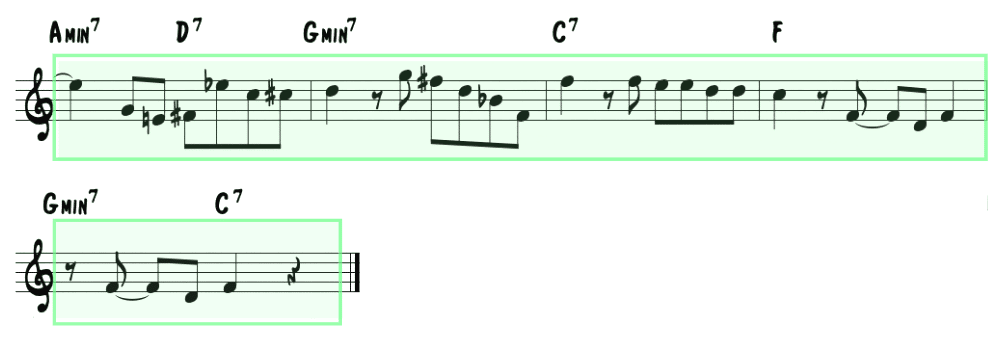
Practice each phrase in all keys as an approach to the I chord, the IV chord, and the iii-VI-ii-V of the Blues, not only reinforcing your mastery of the form, but ingraining a melodic and phrasing approach in every key.
2. Au Privave
Another simple blues melody that uses some of the same musical techniques as the previous tune is Bird’s Au Privave…
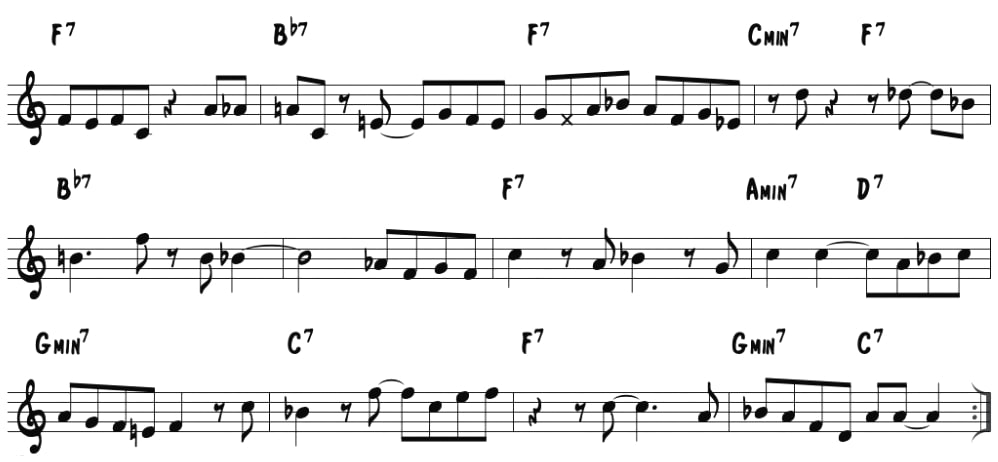
Again we find a melody that has a melodic and phrasing freedom over the blues, yet built around the major triad or basic chord tones of the I chord:

In this tune Parker utilizes the transition to the IV chord in the fourth bar and emphasizes blues language/blue notes on the IV chord:

Try to incorporate both of these tactic in your approach to the blues along with the rhythmic and phrasing characteristics of these bebop melodies. Here are some other bebop blues tunes to check out in your practice:
- Now’s the Time
- Bloomdido
- Mohawk
- Cheryl
- Barbados
Rhythm Changes
Along with the blues, another essential song form that many bebop tunes are based on is the chord progression to Gershwin’s I Got Rhythm, commonly referred to as “Rhythm Changes.”
Again it’s useful to start with a solid foundation on the form of Rhythm Changes before jumping into all of these bebop heads – here are two lessons to check out:
As you’ll see below, many tunes also utilize a Rhythm Changes bridge so it is essential that you have some techniques for this sequence as well.
Here are 3 simple bebop rhythm changes tunes to get started with…
3. Steeplechase
A great intro to bebop Rhythm Changes is Parker’s tune Steeplechase – a simple 8 bar melody with an improvised bridge that introduces some rhythmic and harmonic interest.

Bird opens with a I to ii-V-I approach to the first two measures starting on the upbeat…
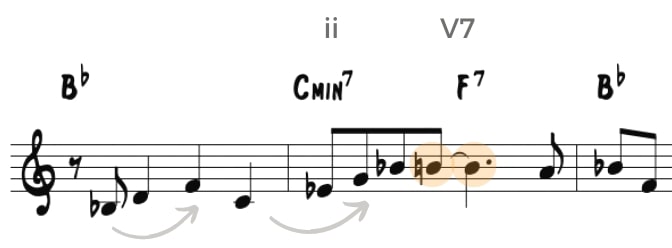
Here he plays a triad on the I chord and arpeggiates the ii chord, emphasizing the #11 on the V7 chord before resolving to I, hinting at the tritone substitution. The distinctive or highpoint of this phrase is the harmonic tension caused by this tritone.
In the next phrase he highlights the b9 on the V7 chord before descending chromatically over the ii-V leading to I:

The bridge of this tune, like many Parker rhythm changes heads, is left open for improvisation:

This tune presents some different ways to think about the opening four bars of Rhythm Changes, approaching the first four bars in a melodic way, simplifying the harmonic approach to I – ii V – I or simply I – V – I, and then incorporating dominant alterations at key points
4. Red Cross
The next Rhythm Changes tune we’ll look at is Bird’s Red Cross, another melody that presents a simplified approach to the first four bars of the tune while incorporating harmonic interest or tension in the next four bars…
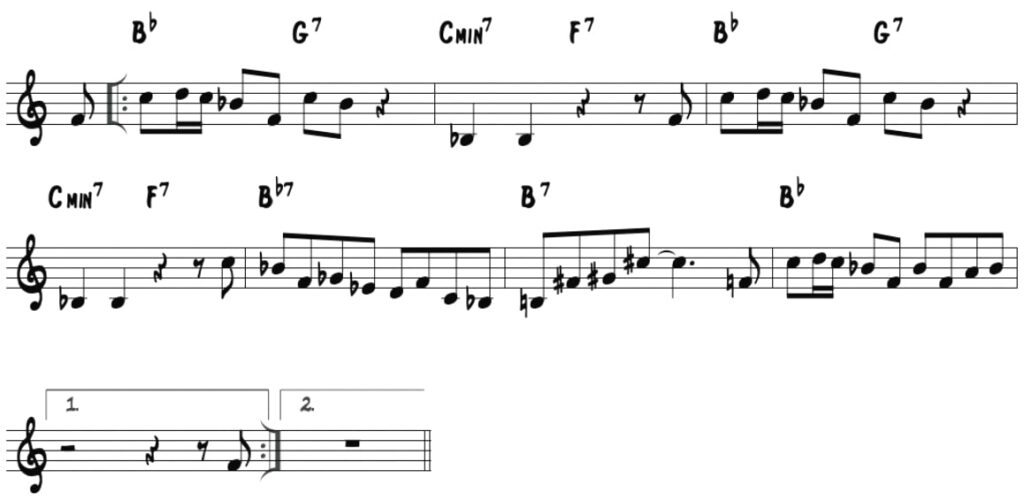
Here, Parker approaches the first 4 bars of the form as the tonic or I chord. Making a melodic statement in the tonic rather than trying to incorporate every passing chord, while letting the phrasing and rhythm provide the interest:

In the next four bars the harmonic tension comes in with a tritone sub, B7 in place of F7:

Rather than the typical IV to #ivº chords or backdoor V7 in the 6th bar of the form, here Parker applies a tritone sub that catches the listener’s ear and then resolves back to I.
Bridge: The bridge consists of one melodic idea that is repeated over each successive chord, demonstrating a simple technique for approaching this section of Rhythm Changes:

The musical figure here is essentially an ornamented enclosure of the 3rd of each chord that then jumps up to the root:

5. Crazeology
Like the previous tune, Parker’s Crazeology approaches the form with a simple diatonic melody and inserts a section harmonic tension. (This tune is also recorded under the title “Little Benny”).
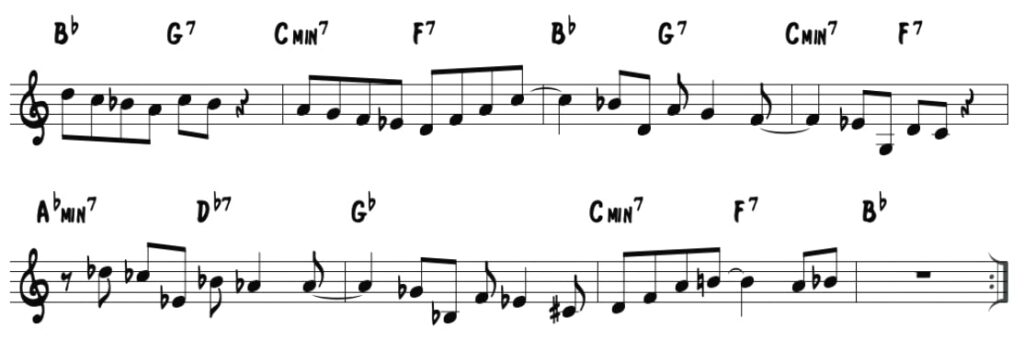
Again Parker takes a simplified I-V-I approach to the first four bars, using a diatonic melody:

In the fifth bar you see a harmonic alteration/variation: ii-V to the bVI (a half-step above the V7 chord) before playing a diatonic ii-V back to I:

Also note how the b5 on the final F7 is emphasized before resolving back to I, the same exact concept we found in the tune Steeplechase above.
Bridge: On the bridge Parker writes two different approaches to the dominant chords on the bridge…

Here you’ll find a simple diatonic V7 phrase on the first and third chord and an implied ii-V on second and fourth chords:

From these three tunes, you can see that your melodic and harmonic approach to Rhythm Changes doesn’t have to be harmonically complicated or full of notes that match every single chord…
It’s all about creating strong melodic statements with clearly defined rhythm and manipulating the harmony at specific places in the form. Strive to apply these ideas to your own melodic concept as you improvise.
Here are some other Rhythm Changes tunes to check out that utilize many of the melodic and harmonic techniques that we covered in the 3 tunes above:
- Passport
- An Oscar for Treadwell
- Salt Peanuts
- Dizzy Atmosphere
- Chasin’ the Bird
- Passport
Adapting the Standard Repertoire
Along with the blues and rhythm changes, many bebop tunes are based on the form or chord progressions of existing standards – also known as contrafacts.
These were often taken from the popular tunes of the day, show tunes, or older standards that were commonly played. On top of these existing songs a new melody was composed and the chord progression might be altered.
*When learning these tunes it’s important to go back to the original tune to understand the form and melody, the simpler root that the more complex bebop approach is based on.
6. Ornithology
One of the most popular contrafacts of the bebop era is Charlie Parker’s Ornithology, based on the well known standard How High the Moon written by Morgan Lewis in 1940:
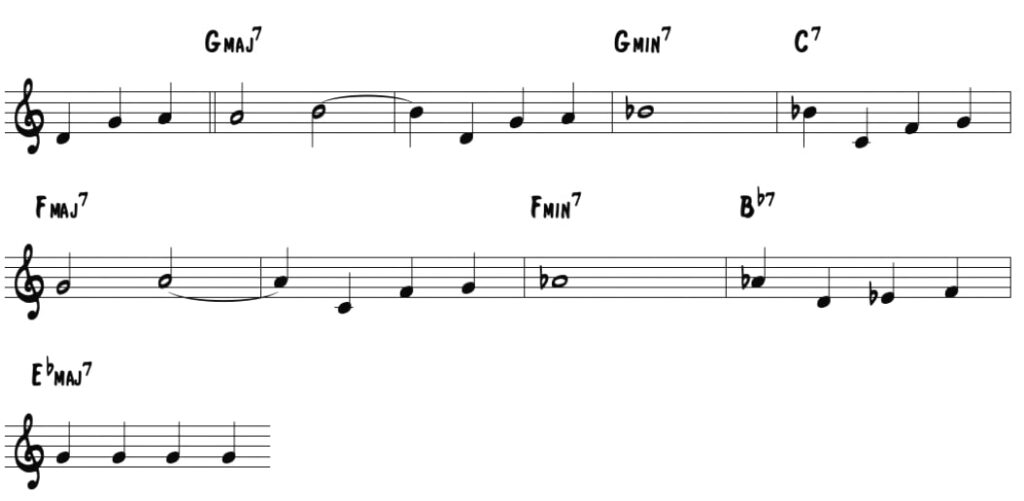
This tune features a sequential melody over a harmonic progression that moves between major and parallel minor:
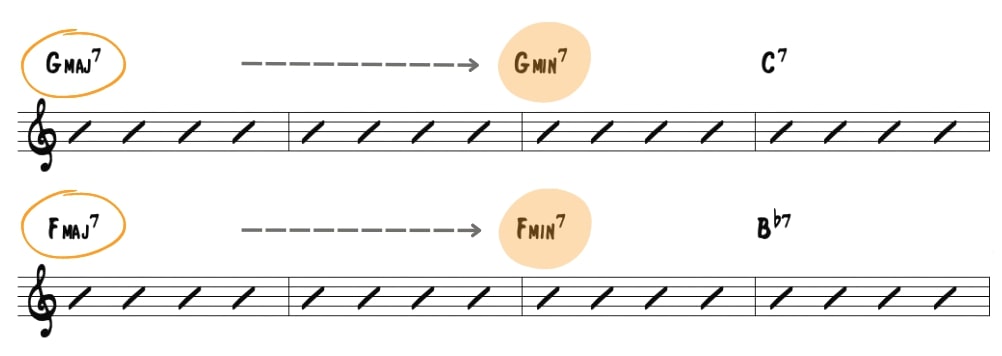
Parker takes this framework and replaces the simple melody with a more complex linear and rhythmic approach:
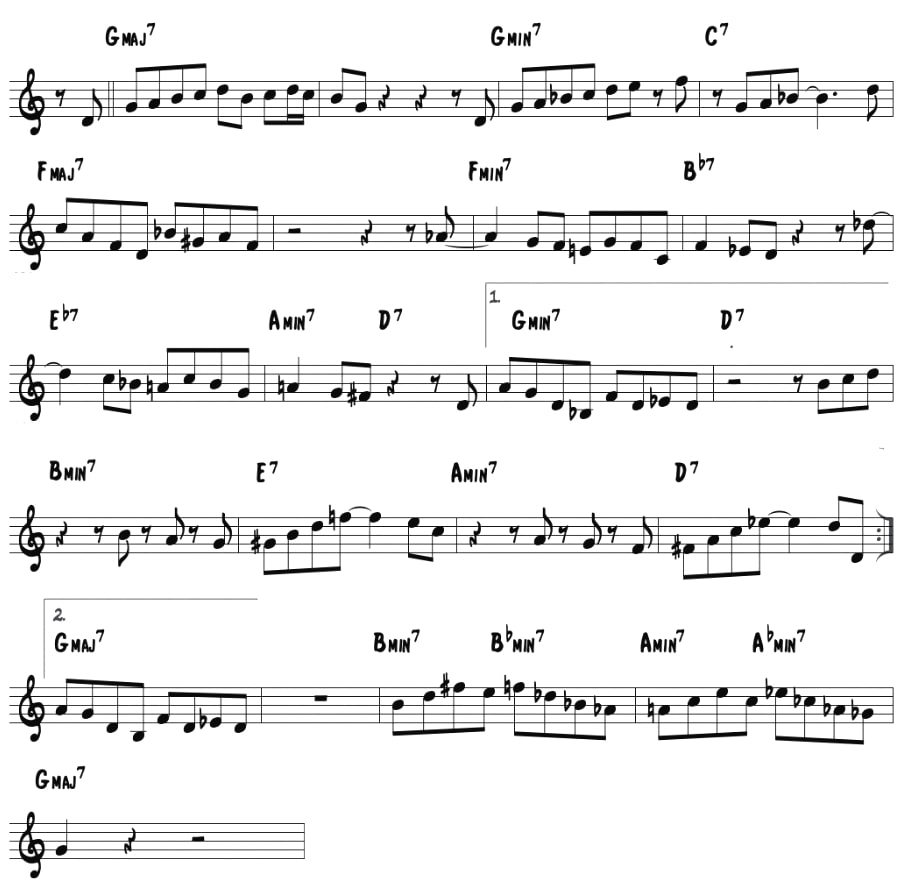
Over this major to minor harmonic movement, Parker writes a diatonic major idea and answers it with a rhythmically similar phrase in the next measure:

And in the next phrase he does the same with F major moving to F minor, mirroring the rhythm of the idea in the parallel minor:

These two opening phrases are good examples of Major/minor bebop language and major to parallel minor motion. Take these opening 8 bars and use them as a practice exercise, listening to the recording and focusing on style, rhythm, and articulation.
*Looking for more information on developing jazz language on the common chords of tunes? Check out this in-depth lesson for Premium Members…Master the Jazz Language: A Step-by-Step Guide to Transcribing the Laguage
Another harmonic element of this progression is the turnaround – iii-VI-ii-V used to return to the I chord:

As an improviser this is a progression that you not only need to know in every key, but on that requires musical tools to navigate. The melody to Ornithology gives us some a great melodic approach to begin with:

This line utilizes enclosure to approach the 3rd of each V7 chord and then highlights the b9, a useful melodic idea to know in all keys.
Note that there are two different endings of the tune. This version utilizes tritone substitution on the dominant chords in the progression (Bb in place of E7 and Ab in place of D7):

Practice both of these turnaround phrases in all keys – visualizing and hearing each chord of the iii-VI-ii-V progression and the variation with tritone subs on the V7 chords.
7. Scrapple From the Apple
Charlie Parker’s Scrapple from the Apple based on Fats Waller’s popular composition Honeysuckle Rose:

*In place of the progression on the bridge, Parker substitutes a Rhythm Changes bridge.
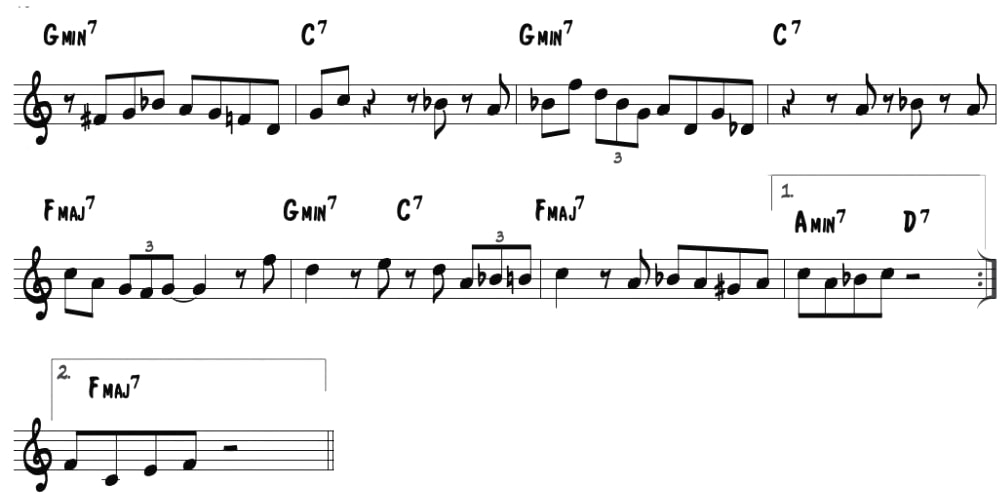
Over this harmonic sequence, you’ll notice a different approach to the ii-V progression. Note how he avoids the traditional 7-3 resolution here or ii-V language and instead focuses more melodic attention on the ii chord (G minor).
Concentrate on the rhythm of the melodic line and where each phrase is placed in the progression, absorbing these principles into your own musical approach.
Bridge: Here Parker opts for a Rhythm Changes bridge that is left open for improvisation, differing from the original bridge of Honeysuckle Rose

8. Yardbird Suite
There is stipulation that this tune was based on an earlier piece by Earl Hines, Rosetta, even though the chord progression slightly differs.
Nonetheless, it’s a tune that contains harmonic elements that were very common in the jazz repertoire, and which Bird creates a distinctive melody over…
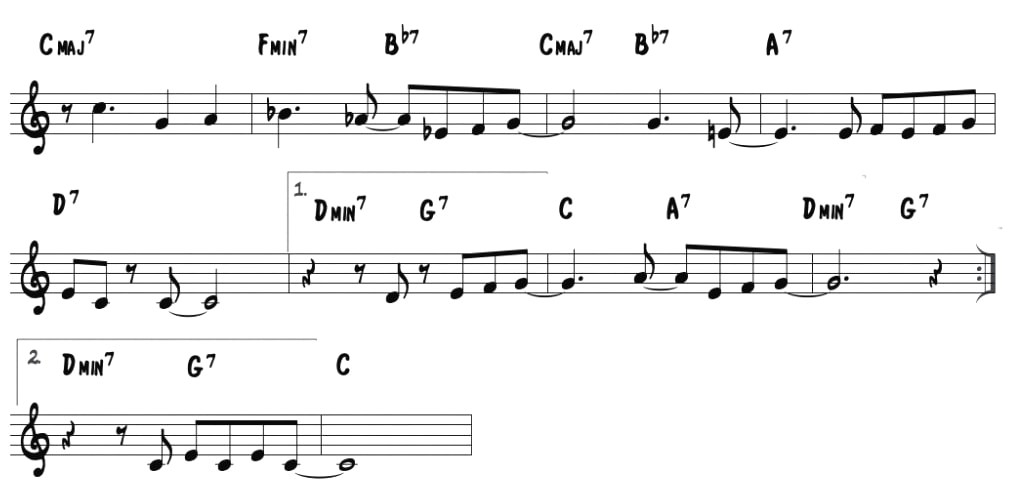
This tune features a bVII7 chord or “backdoor ii-V” resolving to I in the second measure and the II7 sound:

The backdoor (Bb7) works as a V7 chord alternative because it is similar to the diatonic G7 altered (#9, b9, b13) chord, and the melody to Yardbird Suite exploits this effectively:

Another key harmonic point to know is the II7 chord before the final ii-V-I in the tonic. Note that the ‘A’ section to this tune is nearly identical to the progression found in Parker’s Dewey Square.
Bridge: The bridge goes to the iii minor (E minor in relation to C major) then moves down a whole-step to D minor, before stopping at the II7 and resolving back to the ‘A’ section:
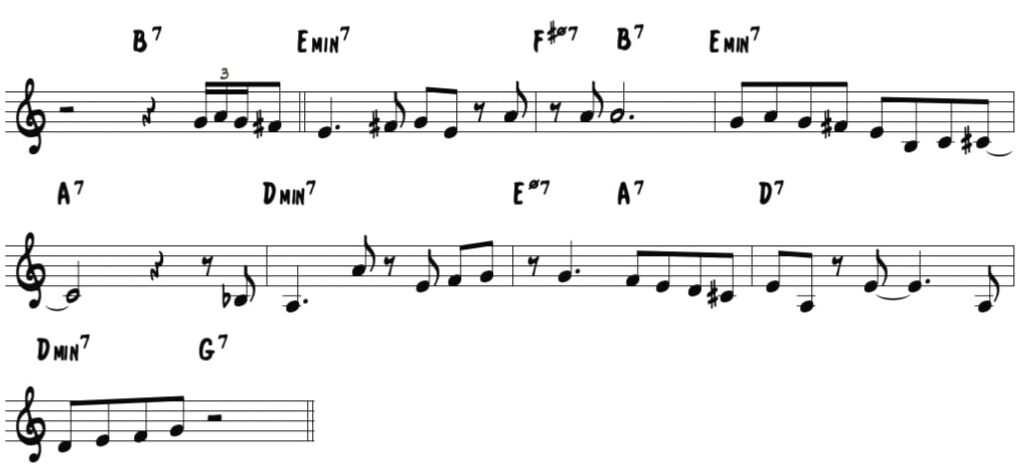
*For some improvisation ideas and further study, check out this lesson – 5 Roy Hargrove Phrases to Master Yardbird Suite
Original compositions
Now we’ll focus on two original compositions of the bebop era from two giants of the music – Charlie Parker and Dizzy Gillespie.
These are tunes are were not based on existing chord progressions, rather composed using the innovative melodic and harmonic elements that each musician was utilizing in their improvisation.
9. Confirmation
A quintessential bebop tune is Charlie Parker’s Confirmation, an AABA composition with some clever harmonic motion and a distinctive bebop melody…
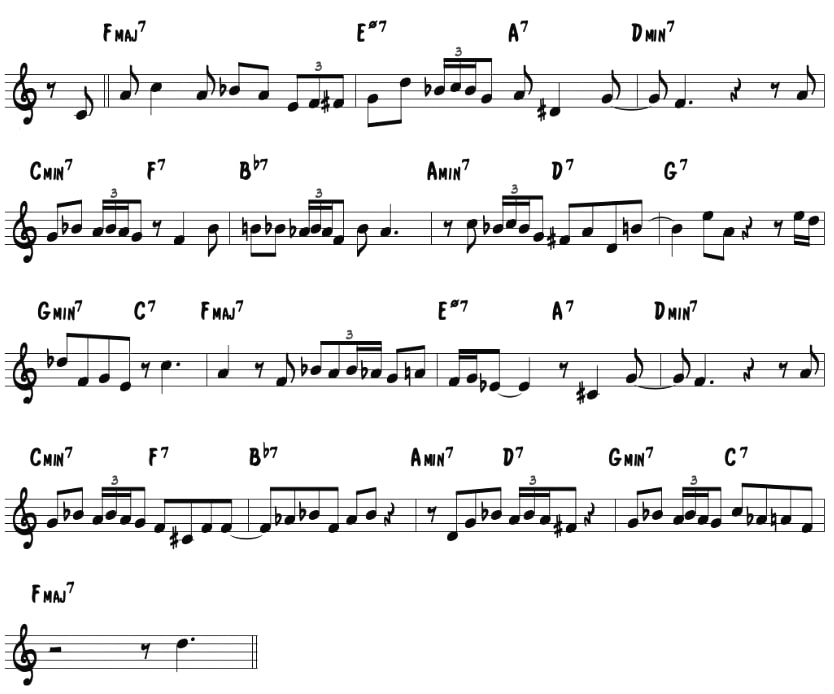
*When learning the melody, take out embellishments or turns at first and slow down the tempo to make it easier:
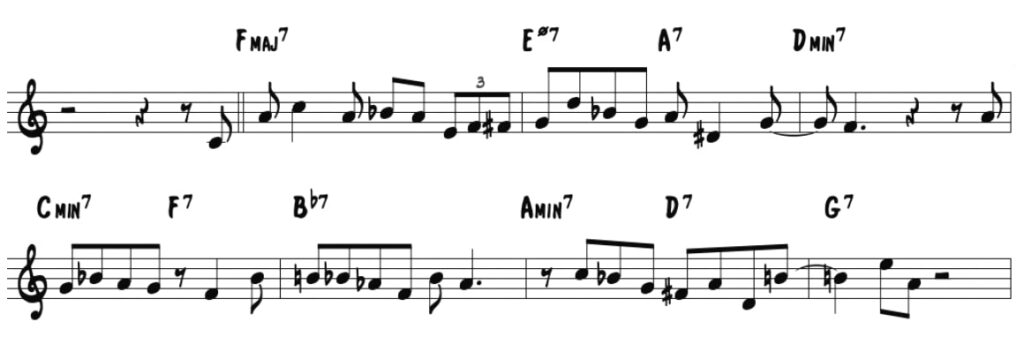
The progression here features clever harmonic movement and key arrival points within the larger key (F major) connected by descending ii-V’s…
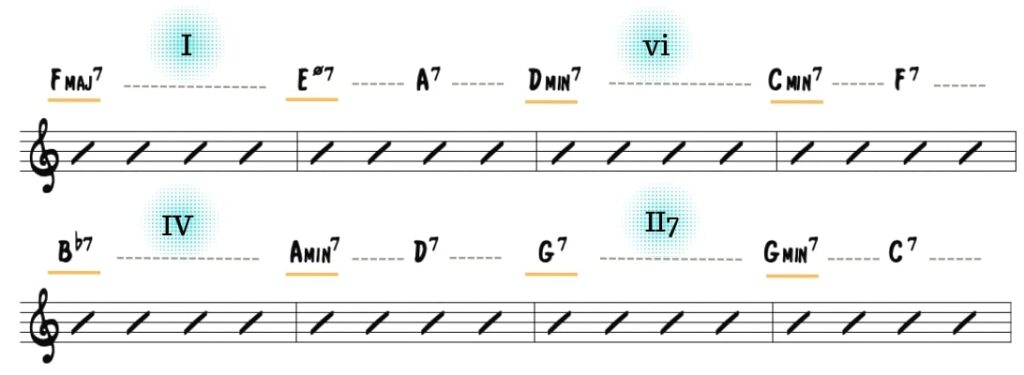
Starting on the I chord, the next arrival point is the vi chord, then the IV, and lastly the II7 before returning to I. This is all connected by related ii-V’s and a descending bass line motion: F to Eø to D– to C– to Bb7, etc.
It is worth spending some time on this progression as it pops up in many jazz standards. The first 5 bars are also the same as the “Bird Blues” progression or Blues for Alice (shown in the next section).
Break the melody up into sections when you’re learning, starting with the I moving to the vi chord:

Then the ii-V to IV chord, (Notice how he applies blues language on the IV chord):

And finally the iii-VI to II7 and the final ii-V to I…

Notice how the melody (and Bird’s solo) doesn’t follow the “cookie cutter” outline of each ii-V in the chord progression, but uses rhythmically diverse and interesting phrases that stretch across bar lines and chord resolutions.
Do the same for the next 8 bars of the A section, breaking down into three larger phrases.
Bridge: The bridge of the tune begins with a ii-V-I on the IV chord (Bb) and then a ii-V up a minor 3rd (Db):
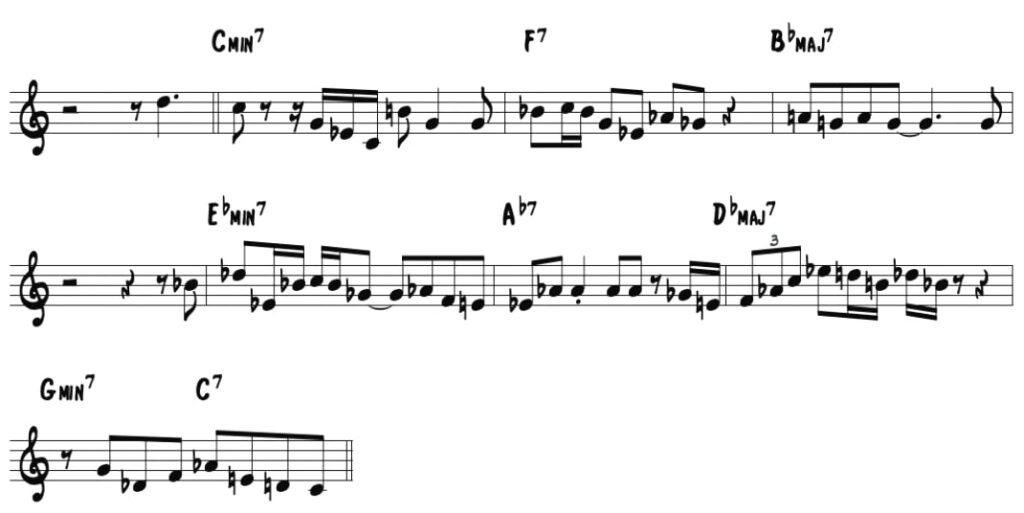
Some techniques to take away from the bridge:
- Utilizing alterations on the V7 chords
- Major language idea on the Db chord
- ii-V language and techniques
- A rhythmic and phrasing approach to common progressions
*For more insight on improvising over this tune, check out this lesson: Charlie Parker’s Secrets to Confirmation
10. A Night In Tunisia
Now we’ll move on to a tune composed over minor harmony – Dizzy Gillespie’s A Night in Tunisia. An iconic tune that features some sophisticated harmonic movement…
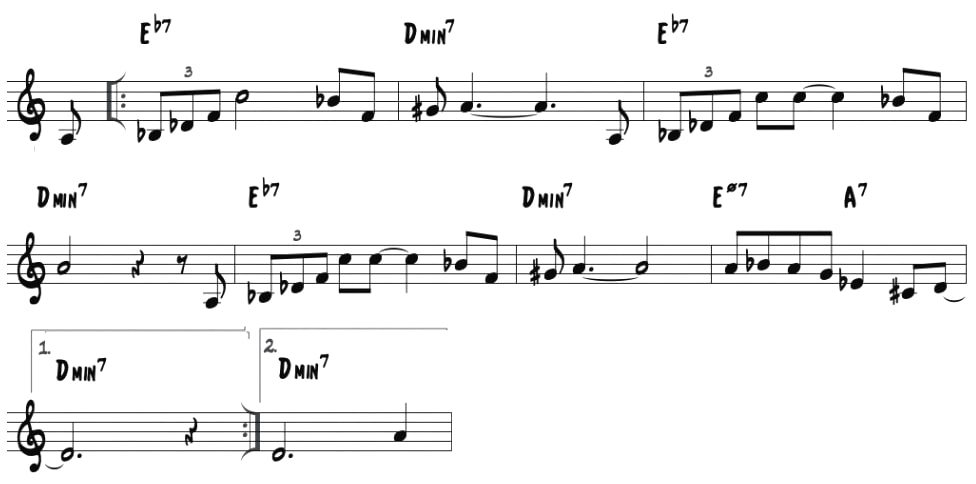
The ‘A’ section is essentially built on the movement of V7 resolving to i in minor, however in this case, the diatonic V7 chord (A7 alt) is replaced with its tritone sub (Eb7):
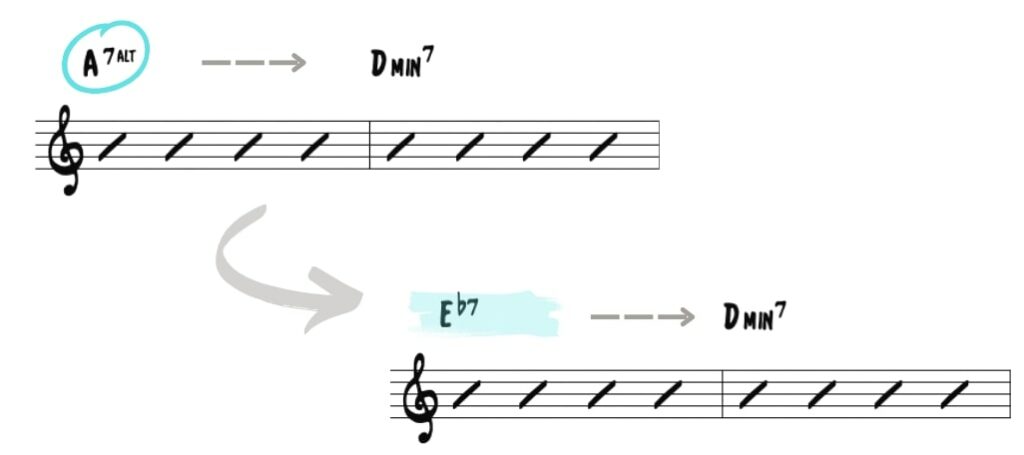
You can also think of the related ii minor of the tritone sub (Bb-) using the b9, #9, b13, and diatonic 3rd of the substituted (A7):

This highlights a larger harmonic relationship – the V7 alt. chord, the tritone sub, the tritone sub ii-V, or the diminished scale. All of these options can be applied to the V7 moving to i and reference the same core sound.
Bridge:The bridge of the tune moves to the minor iv chord, a ii-V to iv (G minor), then pivots to a ii-V to the relative major (F Maj) before a ii-V leading back to i:
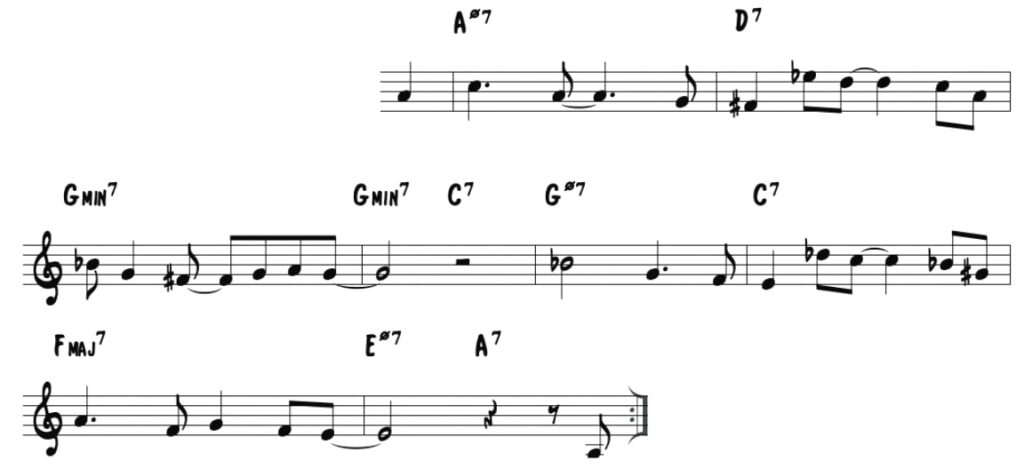
Interlude: One unique aspect of the form of this tune is that it contains an 16-bar interlude with a solo break. The overall harmonic motion moving from the minor i to relative major (D minor to F Major):

Looking closer at the progression, you’ll find a iiø V i in minor with the that utilizes a tritone sub (Eb7#11), a II7 chord, and a ii-V to F major that again uses a tritone sub (F#7) before resolving to I:
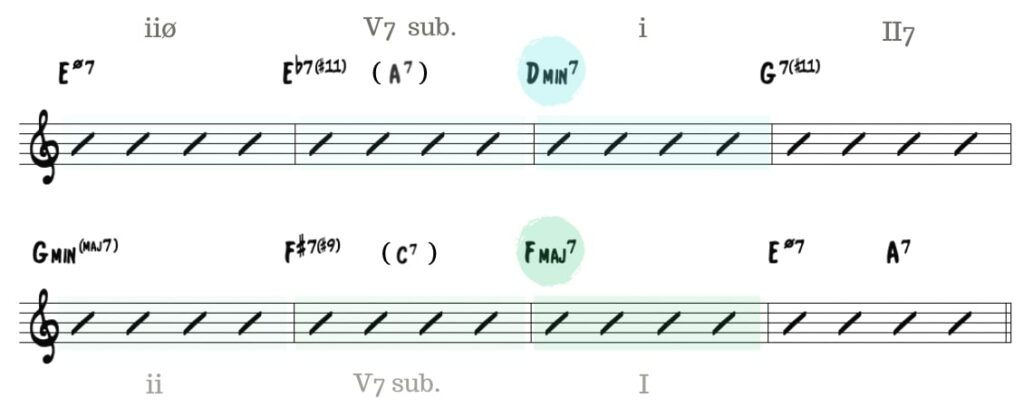
Over this chord sequence, the melody features a 3 note descending motif starting on an A that is taken and adjusted through each chord of the interlude:

The “adjusted” notes create some interesting chord alterations – the #11 on Eb7 and G7 chords, the major 7th on the G minor chord, and the #9 on the F#7 chord.
II. Intermediate bebop tunes

Now we’ll move on to 10 intermediate bebop tunes, compositions that utilize a little more melodic motion and harmonic complexity to build on what you’ve learned with the previous tunes.
Blues
Once again we’ll start with some blues tunes…
Building on the ideas and techniques of the previous blues heads, here you’ll find slightly more sophisticated melodies and some harmonic adaptations to the standard form.
11. Relaxin’ at Camarillo
In Bird’s Relaxin’ at Camarillo, he combines blues language and phrases with the harmonic and rhythmic elements of bebop to create a flowing melodic line.
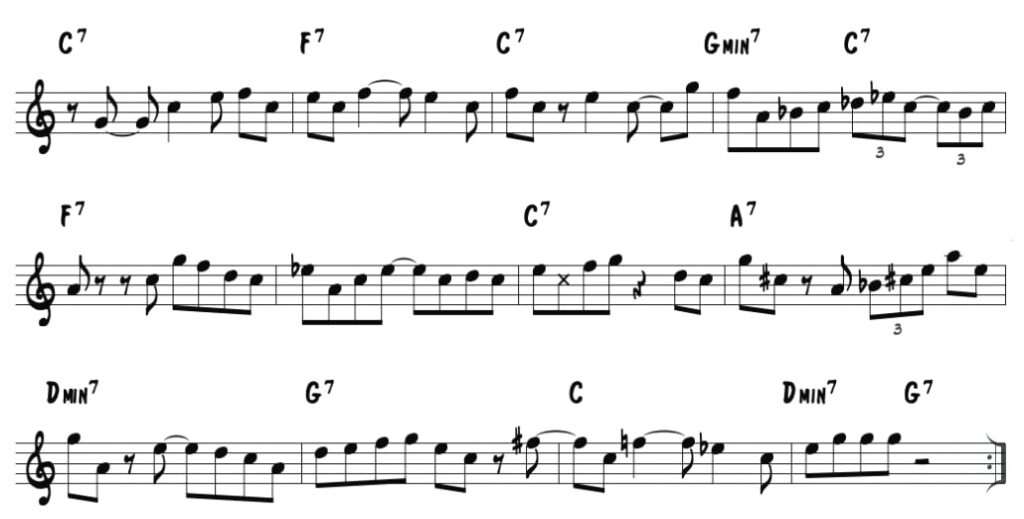
In this melody the larger concept of making blues statements is mixed with bebop language, showcasing one method for creating melodic lines over the blues.
Specifically, Parker uses simple melodic or blues statements on the I and IV chords and then applyies melodic motion or V7 alterations to the 4th bar and the VI chord in the 8th bar.
In the opening phrase Bird creates melody with a simple musical statement – the major triad plus the 4th, while utilizing a rhythmic figure that starts and continues accenting the upbeats:

This is a useful melodic idea to learn in all keys as a piece of major language or a phrase over the I chord in the blues – be sure to imitate the swing and accents of the original recording.
After stating the melodic theme on the I chord he transitions to the IV chord with a ii-V in the fourth bar:
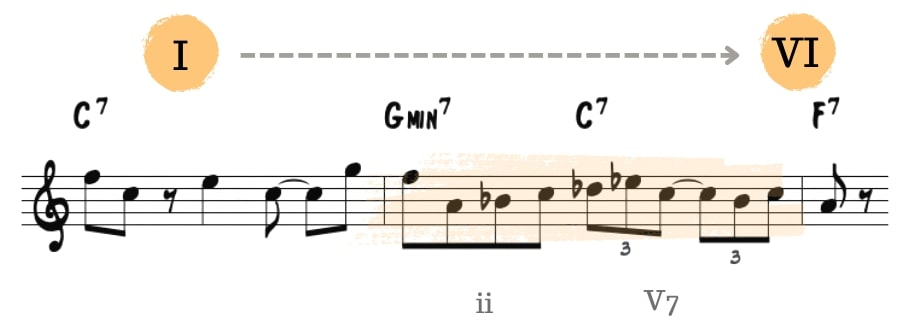
Over the C7 he emphasizes the b9 and #9, resolving to the 3rd of IV chord. Learn this harmonic technique and apply it to the transition between the I and IV chords in the blues.
Another unique harmonic approach in this tune is on the VI7 chord:

In this measure Parker implies a passing diminished sound built from the 3rd of the A7 chord resolving to the upcoming D- chord.
12. Blues for Alice
Charlie Parker’s reharmonization or adaptation of the Blues referred to as “Bird Blues.”
Similar to the opening measures of Parker’s earlier tune, Confirmation, the novel approach to the blues progression found in Blues for Alice utilizes a different harmonic approach to this familiar song form:
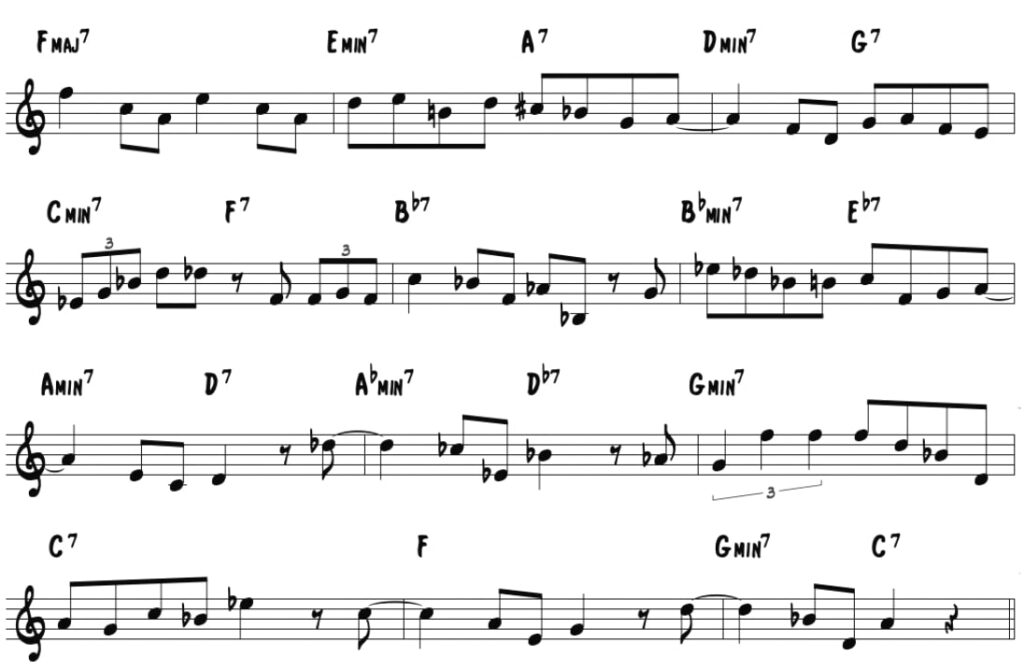
The skeleton of the blues is still here: the I chord moving to the IV chord, then a return to the tonic with a ii-V-I at the end of the form.
But there are some key changes and techniques to note here…Bird uses a Major 7th on the I chord and then applies sequences of ii-V’s connecting the main harmonic points of the progression – I to IV and IV back to I.
Let’s take a closer look at how he gets from the I chord to the IV chord in the first 5 bars:
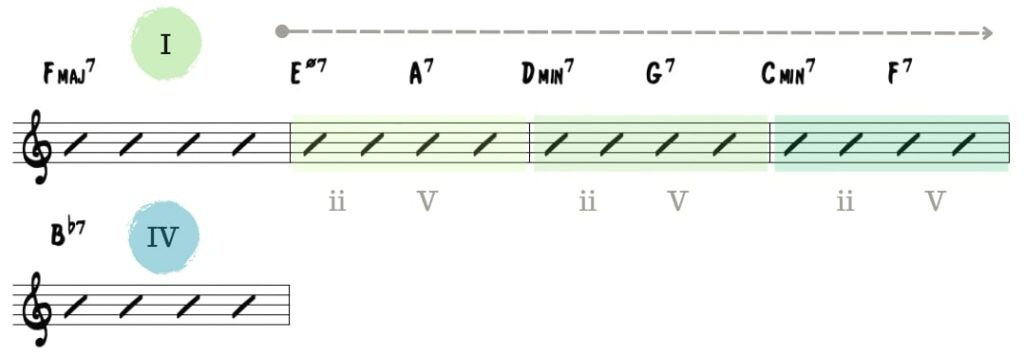
Now check out how the melody navigates these descending ii-V’s to the IV:
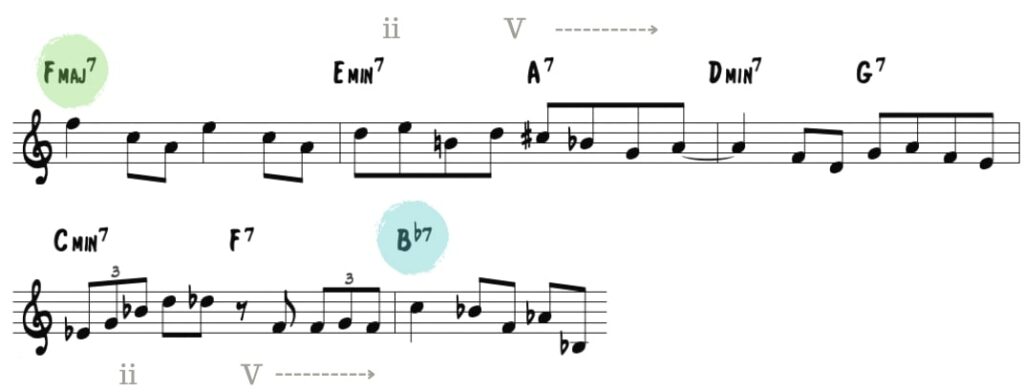
You hear diatonic material and standard ii-V language (enclosing the 3rd of V7, arpeggios, b9’s, etc.) throughout these five measures.
Keep in mind that this section features the same changes as the opening 5 bars of Confirmation, so you can use the same techniques here that you developed over the other tune
Now let’s look at how the progression moves from the IV chord back to the I chord:
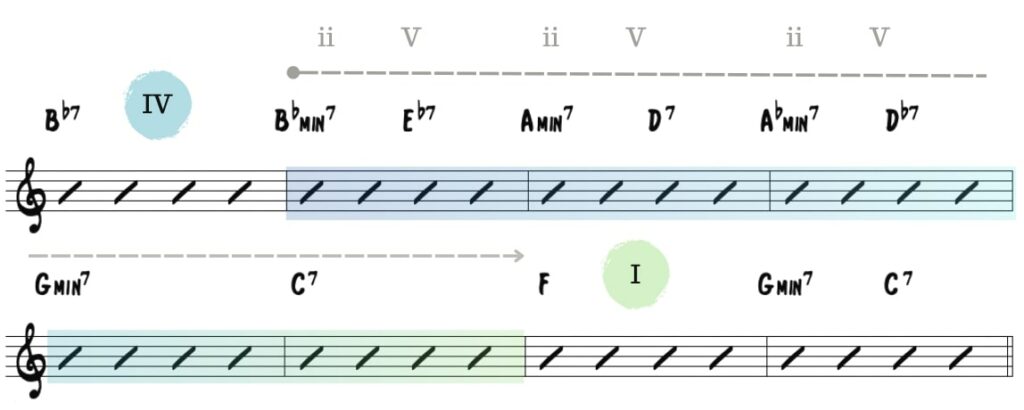
After the IV chord there are a series of ii-V’s descending chromatically until the diatonic ii chord (G-) is reached. Take a listen to the melody in the second part of the form:
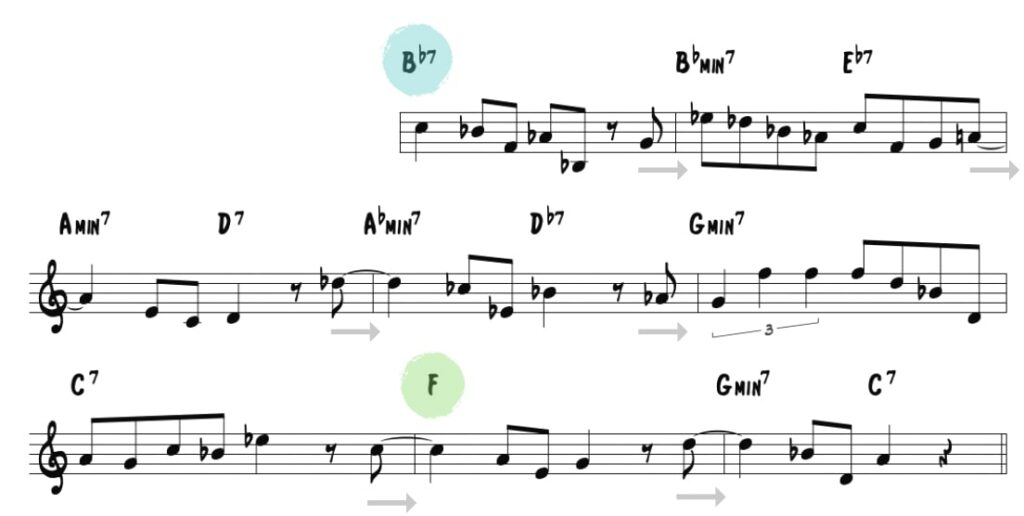
Notice how each phrase or musical ideas is preceded by an 8th note pick-up, anticipating the upcoming sound.
Rhythm Changes
Now we’ll look at some Rhythm Changes tunes that are slightly more complex, this time using a more linear or melodic approach to the progression with bebop language…
13. Anthropology
Bird’s Anthropology is a great first step for developing melodic phrases over the quick harmonic rhythm of this song form…
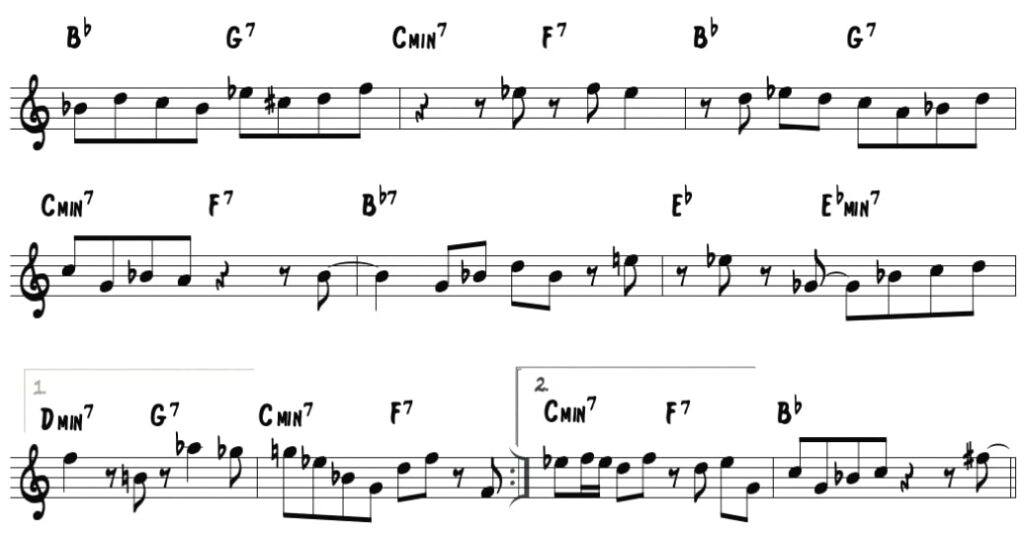
Again, he is not outlining every single chord with the melody in the first four bars, instead taking a more linear approach to his phrases. Notice how he bases his lines around a simpler I-V-I approach:

After implying blues language on the IV chord the melody features a turnaround line emphasizing the b9 on the VI chord that is worth ingraining in all keys:
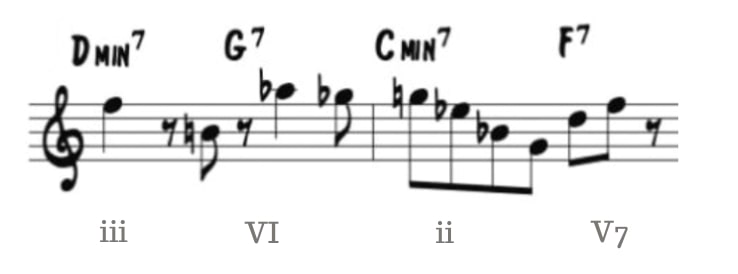
Bridge: The bridge of Anthropology (and the 2 tunes that follow) is a great model for studying how to create linear phrases on the bridge of Rhythm Changes…

A few details to focus on are:
- A diatonic approach to first chord with a chromatic passing tone
- Highlighting the upper-structures of the G7 and C7 chords (9th and 13th)
- Implying a ii-V on the last chord (F7)
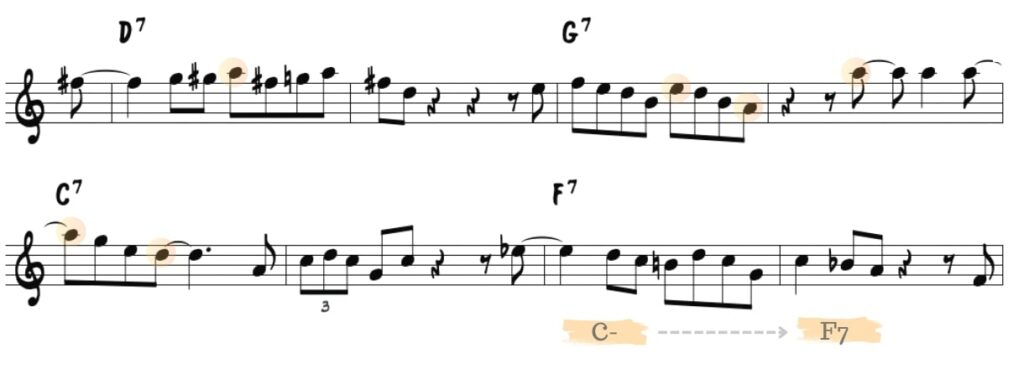
14. Dexterity
Another frequently played Rhythm Changes head is Charlie Parker’s Dexterity:
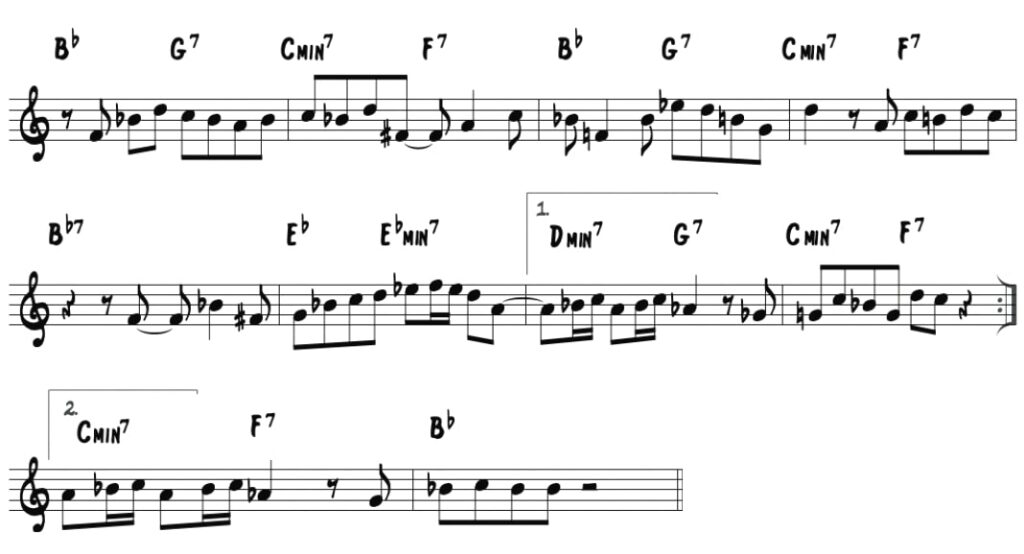
After a statement on the I chord, Parker emphasizes the b9 on the V7 chord before resolving to I again:

Note the rhythmic content here – extending phrases over the bar line and accenting upbeats vs. resolving lines neatly with each measure.
Bridge: On the bridge, Parker writes the following lines:

In these phrases, the related ii-V is referenced on three of the dominant chords (D7, C7, F7) and the G7 is approached with diatonic V7 language.
15. Moose the Mooche
Another Rhythm Changes tune that is often played is Bird’s Moose the Mooche:
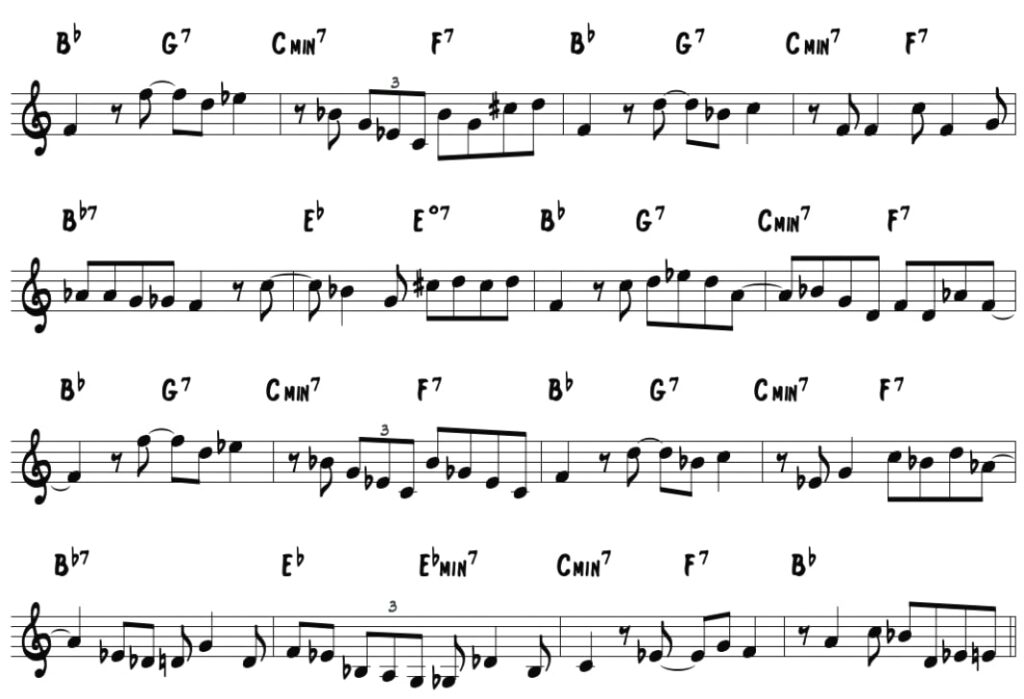
Once again you find a simplified I-ii-V-I melodic approach to the first four bars of the A section as opposed to outlining the I-VI-ii-V progression:

Another part of playing Rhythm changes that can often be confusing is the progression in the 5th and 6th bars in the A section, moving from I7 to IV to iv or #ivº. The melody here gives us two clues for creating melodic lines.
The first example is moves from the IV to the #ivº chord back to the I:
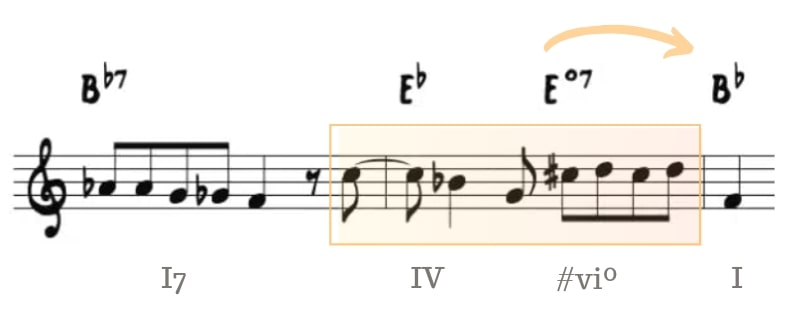
And the second example moves from the IV chord to the iv minor chord to the diatonic ii-V:

Do the same with each phrase of the melody, studying how it relates to the underlying chord and larger form of the tune as a whole.
Bridge: The melody on the bridge also provides a framework for improvising melodic lines over the cyclical movement of the progression:

Here you hear a kind of “call and response” between the phrase first chord (D7) and phrase on the second chord (G7). Note the rhythm of the three 8th notes and how this figure is repeated on the bridge.
Contrafacts
Now we’ll look at three tunes composed over existing progressions from the popular repertoire of tunes…
16. Groovin’ High
The first is Dizzy Gillespie’s well known tune Groovin’ High, based on the changes to Whispering. Take a listen to the original melody:

The original progression features a notable harmonic feature in the 3rd and 4th bars, in the key of Eb major you encounter a ii-V (A- D7). This is a ii-V to the iii chord (G minor) that resolves back to the I chord instead:

And Gillespie makes use of this in his melodic reconstruction…
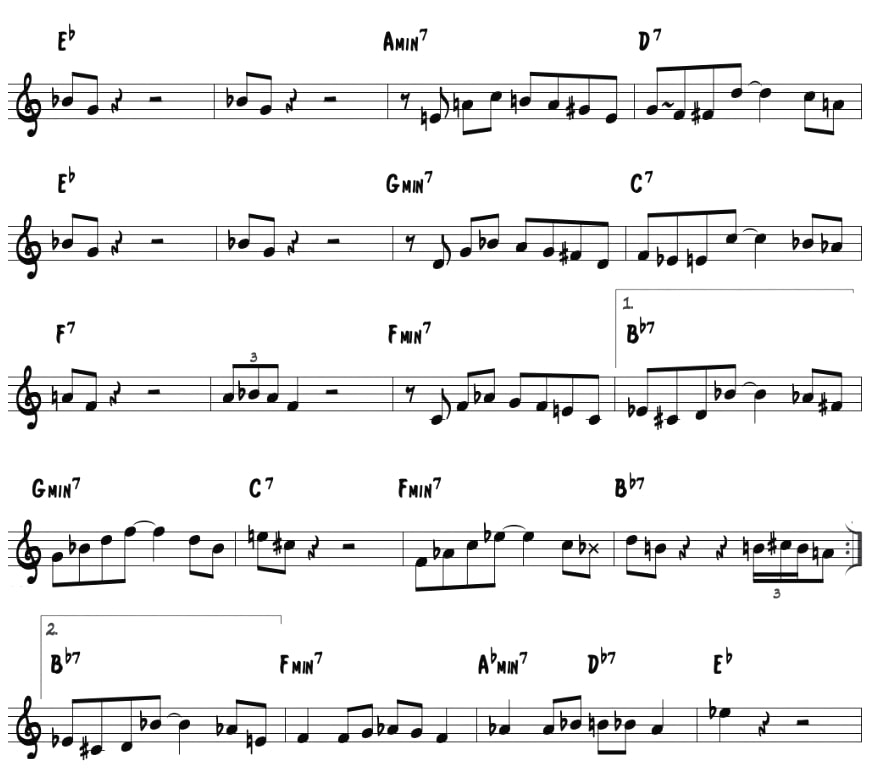
In the 3rd measure, over the ii-V to the iii, the melody features a ii-V line which is repeated twice more down a whole-step each time:

This is a good example of a bebop ii-V to learn in all keys, with chromatic motion descending from root and enclosing the 3rd of V7 chord:

Another part of the melody to focus on is the turnaround or iii-VI-ii-V progression at the end of the form. Here he arpeggiates the iii and ii chords and hints at the tritone subs on the dominant chords (emphasizing b9):

17. Nostalgia
The next contrafact we’ll look at is Fats Navarro’s Nostalgia based on the progression to Out of Nowhere, written by Johnny Green in 1931…
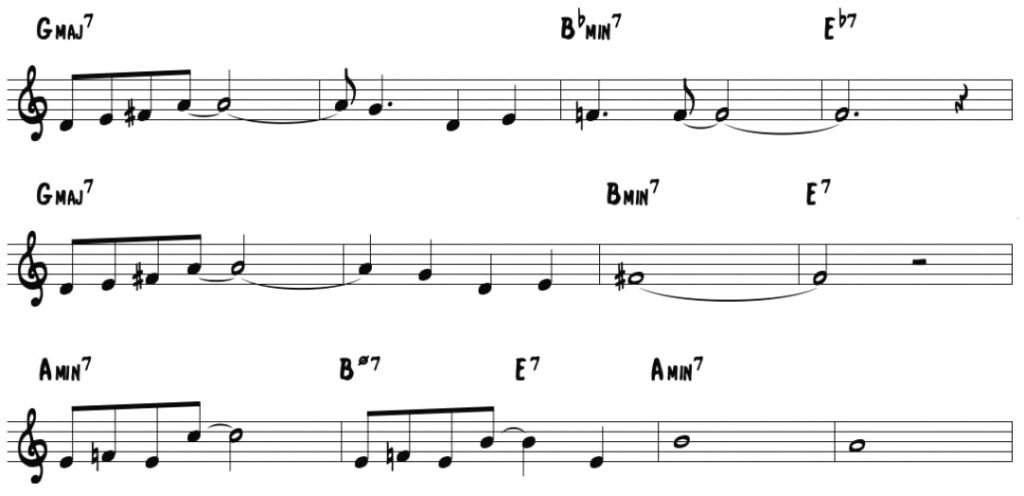
The distinctive harmonic movement in this tune comes from in the third measure, a ii-V a half-step above the diationic ii-V (Bb- Eb7 vs. A- D7)…

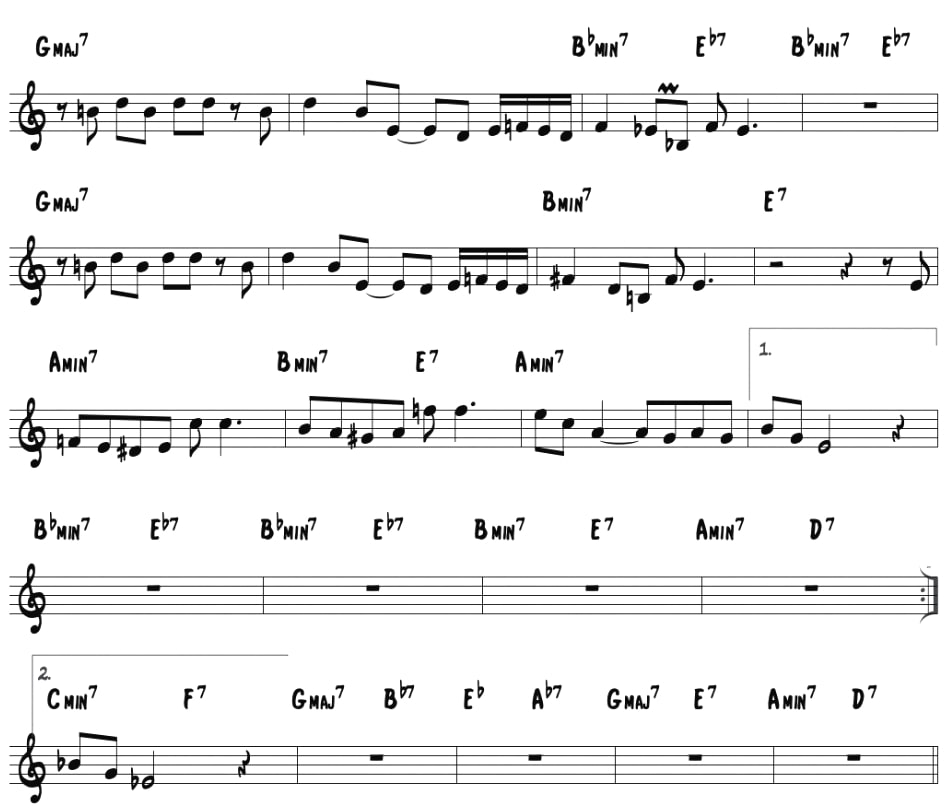
Over this familiar chord progression, Fats writes a sequential melody, utilizing repetition of three phrases. The first going to ii-V up a half-step then from I to the iii-VI:
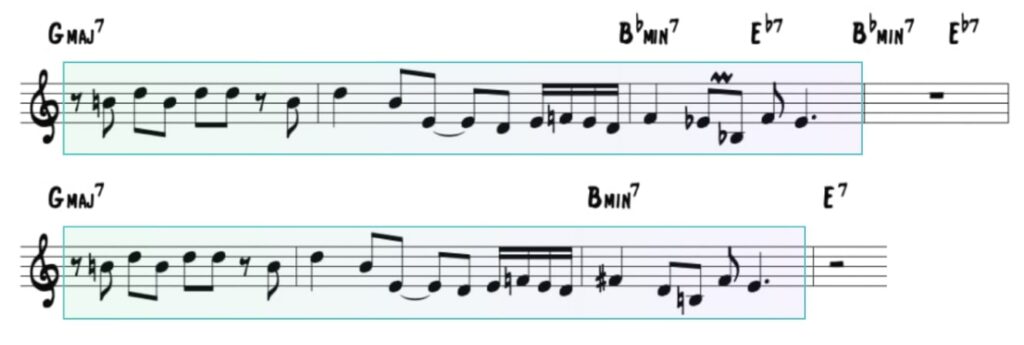
The second over the i-ii V-i on the minor ii chord:
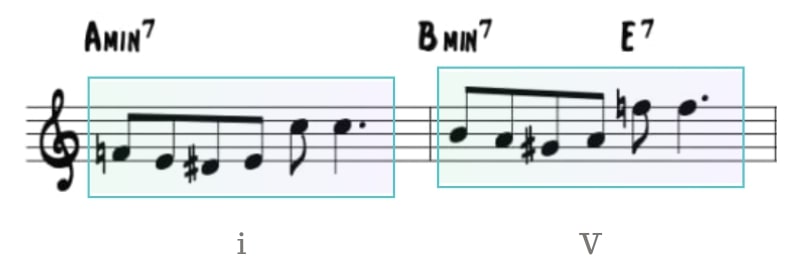
And the 3rd repetition a descending arpeggio on the minor ii:

It’s also worth checking out Fat’s solo on this tune, which is like another composition in itself…
18. Quasimodo
Parker’s contrafact on George Gershwin’s 1928 classic ballad Embraceable You

In performance Parker often improvised freely over this tune, only hinting at the composed melody, and his tune Quasimodo is an extension of this improvisation…
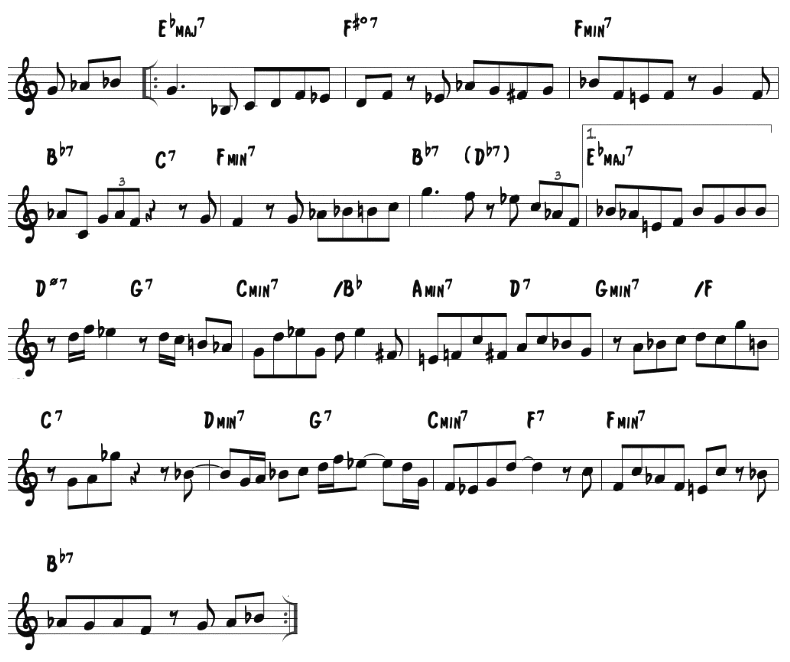
Last 10 bars (C section):
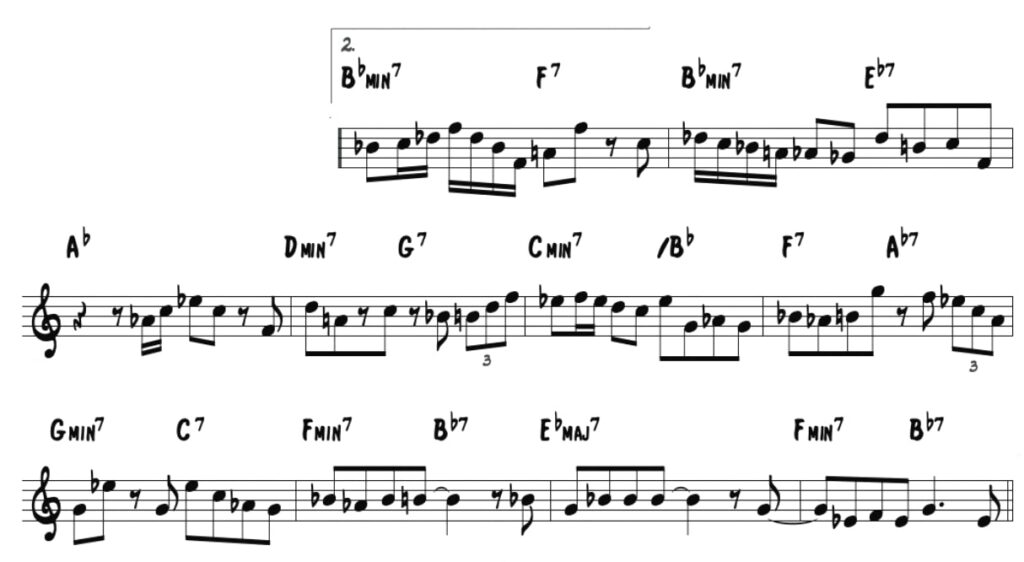
This is a melody that looks simple on paper, yet is surprisingly tricky when you try to play it. This melody is much more like an improvised solo than the other tunes on this list.
Approach is slowly and in small sections, only attempting it on your instrument after you’ve ingrained it in your ear.
Original Compositions
We’ll round out this section of intermediate bebop tunes with two compositions from the great Bud Powell and Charlie Parker…
19. Bouncin’ with Bud
Bud Powell’s composition Bouncin’ with Bud is one of his more well-known tunes featuring an AABA 32 bar form:

On first listen, this progression may sound similar to Rhythm Changes, however it’s a 32 bar form with a few key differences…
In the first two measures, the chords move up step-wise from the tonic of Bb rather than a typical I-VI-ii-V progression:
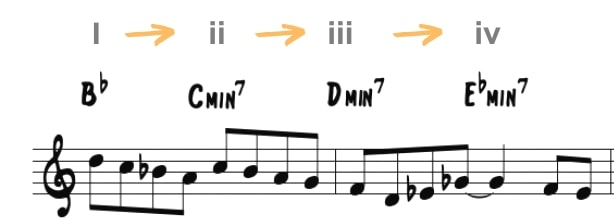
He then moves to vi chord in 5th bar instead of the IV chord:

The Bridge moves to the relative minor (G-7):
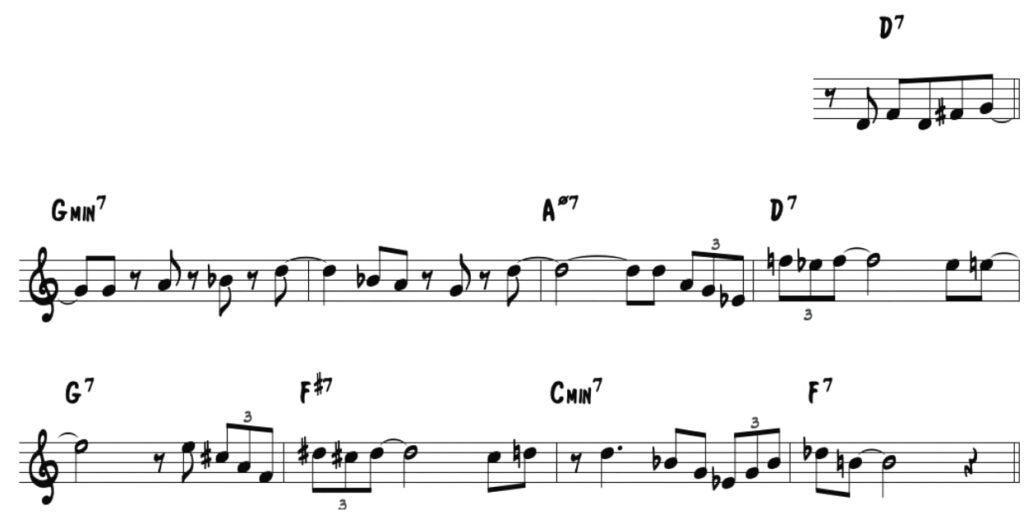
From the relative minor, Powell plays with your expectations again, moving to a ii-V in G minor right to cycle movement that leads back to the ii-V in the tonic…D7 to G7 to C7 (F#7) to F7.
20. Segment/Diverse
Finally, we’ll look at another bebop tune composed in minor harmony – Charlie Parker’s Segment also recorded under the title Diverse:
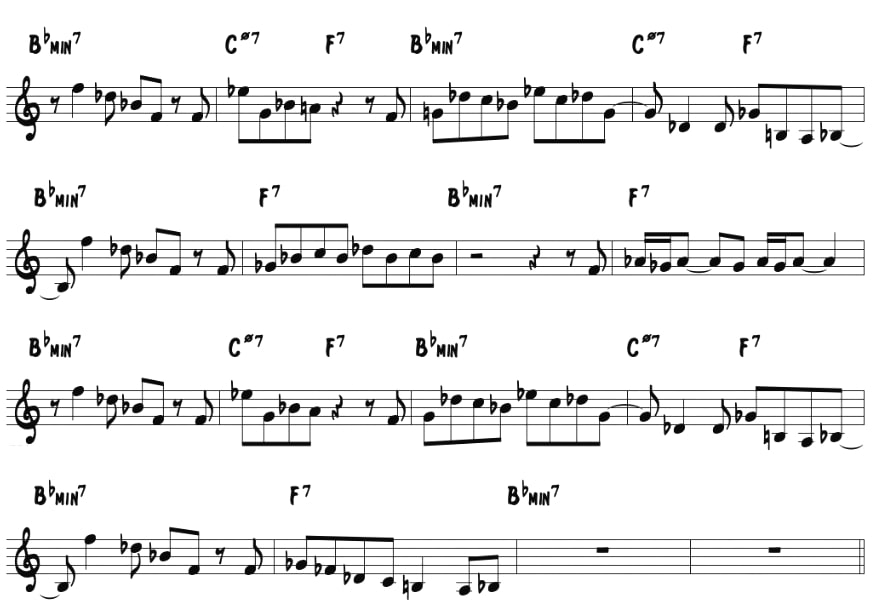
The harmonic content here is simple, i – iiø V – i in the key of Bb minor, and as such, this melody is a good template for developing a melodic approach in minor keys and adding to your minor language …
On the first statement you’ll find an arpeggiated root minor triad moving to the V7 chord in the next measure, enclosing the 3rd of the V:
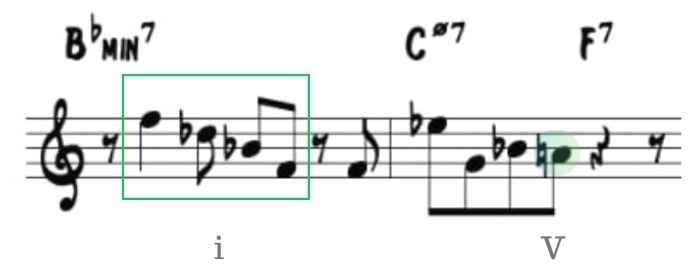
Notice how Parker also emphasizes the distinctive sound of the natural 6th/13th in minor, another harmonic color you can use on minor sounds:
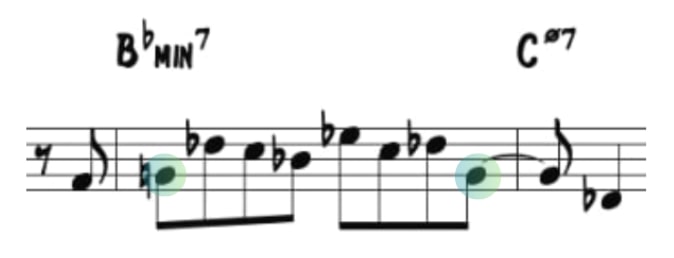
The phrase over the first four bars over the i-iiø V-i progression is a useful one to learn in all keys to develop your minor language:

Also note how Parker approaches the V7 sounds in minor:

…emphasizing the altered sound of #9s and b9s and then using the b13 along with the #11 (hinting at a tritone sub) to resolve back to the minor i chord.
Bridge: On this tune, like a number of others, Parker leaves the bridge open for improvisation:

Here you’ll find common harmonic elements in a minor key: ii-V to the minor iv chord (C-), ii-V to the relative major (Bb), and then a short ii-V back to the final A section.
iii. Advanced Bebop Tunes
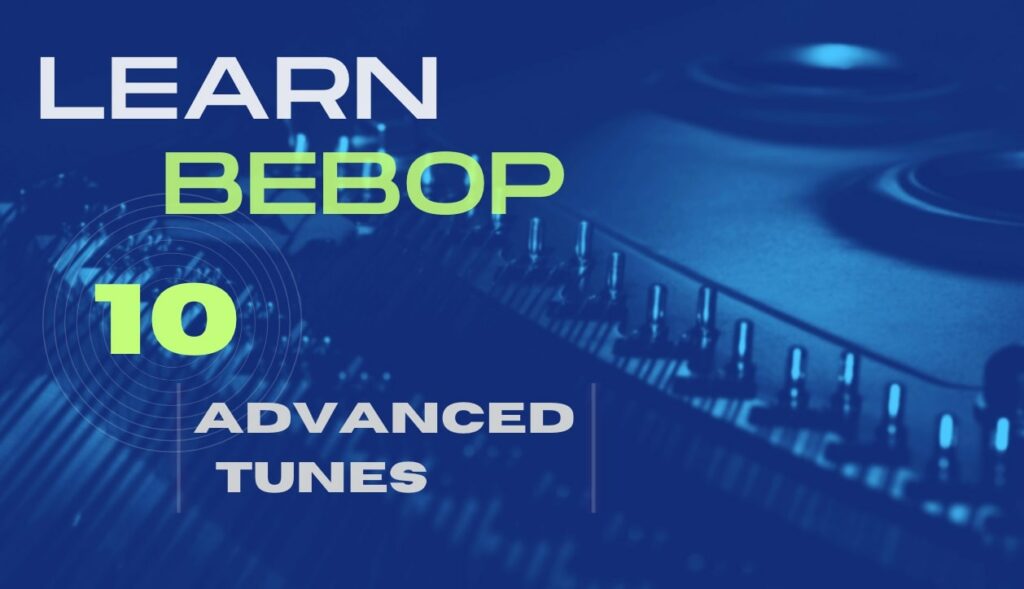
Now it’s time to put all the pieces together and apply all of the musical details of the previous tunes…
The 10 tunes in this final section feature intricate lines, faster tempos, and more complex progressions. These compositions are a great framework for getting your technique, ears, and harmonic & rhythmic skills together – in a sense etudes to be practiced slowly, one at a time.
Blues
We’ll begin again with the blues, but this time, focusing on two alternative approaches to the standard blues progression you’re familiar with…
21. Laird Baird
Parker’s Laird Baird is another “Bird Blues,” utilizing a descending sequence of ii-Vs to get and from the IV chord…
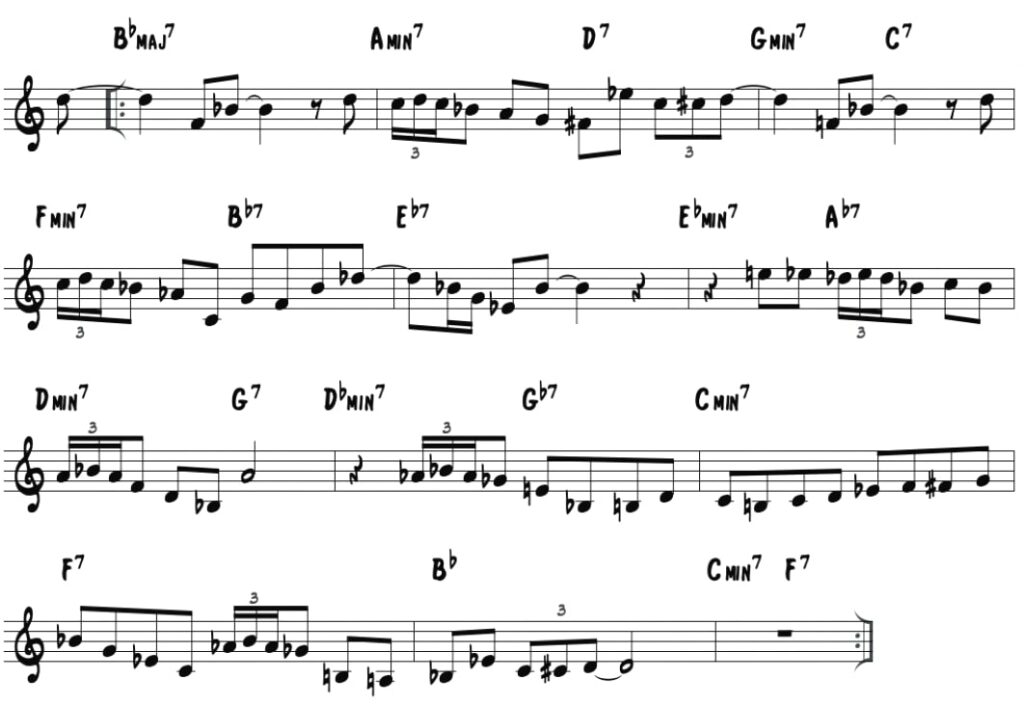
As opposed to the clearly defined structure of Blues for Alice, here Bird creates a melody that is more free flowing, almost an extension of his improvised ideas.
Over this form, he uses a three note motif in the first five bars anticipating each of the harmonic “arrival points” – the I chord, the vi chord and the IV chord:
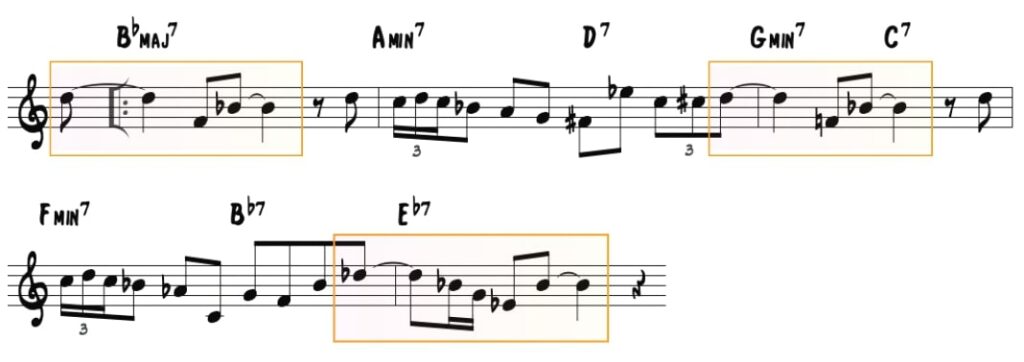
Between these arrival spots you’ll find standard jazz language over the ii-Vs that is ornamented:
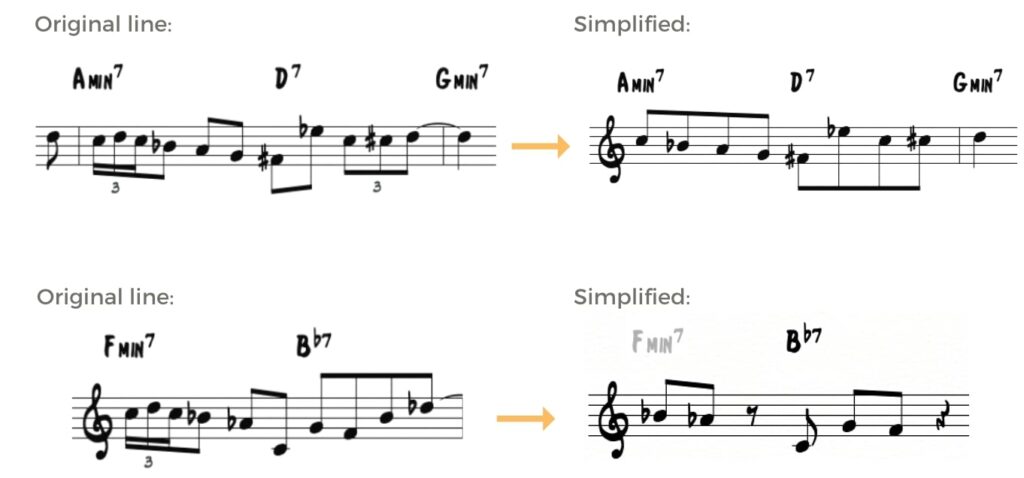
The final ii-V is also a phrase with some important bebop techniques:

Here are a few techniques to learn and apply in your approach to ii-V’s…
- Utilizing chromaticism in linear construction
- Implying ii-V over V7
- Emphasizing alterations on the F7 chord (#9, b9)
- Using enclosure to aim for goal notes
22. Dance of the Infidels
Bud Powell’s tune Dance of the Infidels is surprisingly based on a blues structure, in which the form is harmonically disguised:
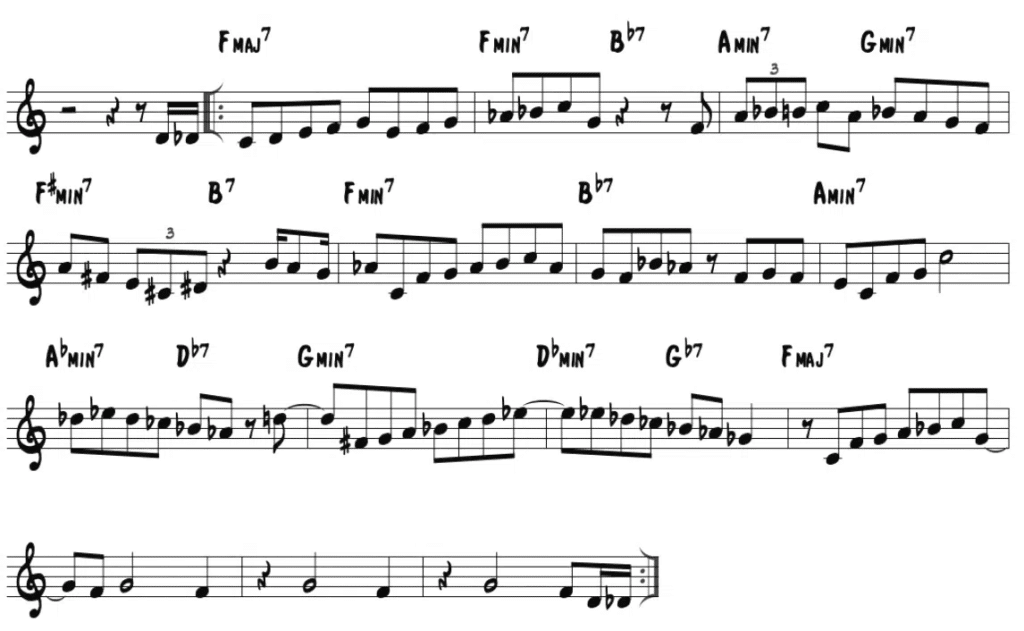
*Check out this lesson for more musical details about Dance of the Infidels and the compositions of the great Bud Powell.
Rhythm Changes
The two Rhythm Changes tunes that follow are like bebop etudes or models for approaching the chord progression using bebop language in a melodic way.
If you’ve been wondering “How do I connect the chords?” or “How do I play longer flowing lines?” these melodies will show you the way.
Learn each melody slowly and as you do, continually referring back to the recording. Try to extract the musical techniques at work – what is each line doing?
These tunes are full of musical techniques and language that you can ingrain and apply to a number of musical situations. Language and techniques for Major, minor, and V7 chords, ii-V-I’s, turnarounds, tritone substitution, etc.
23. Shaw Nuff
Dizzy Gillespie’s Shaw Nuff is a complex melody played at a tempo, but when you study it, you’ll find many familiar musical techniques employed in a clever way:
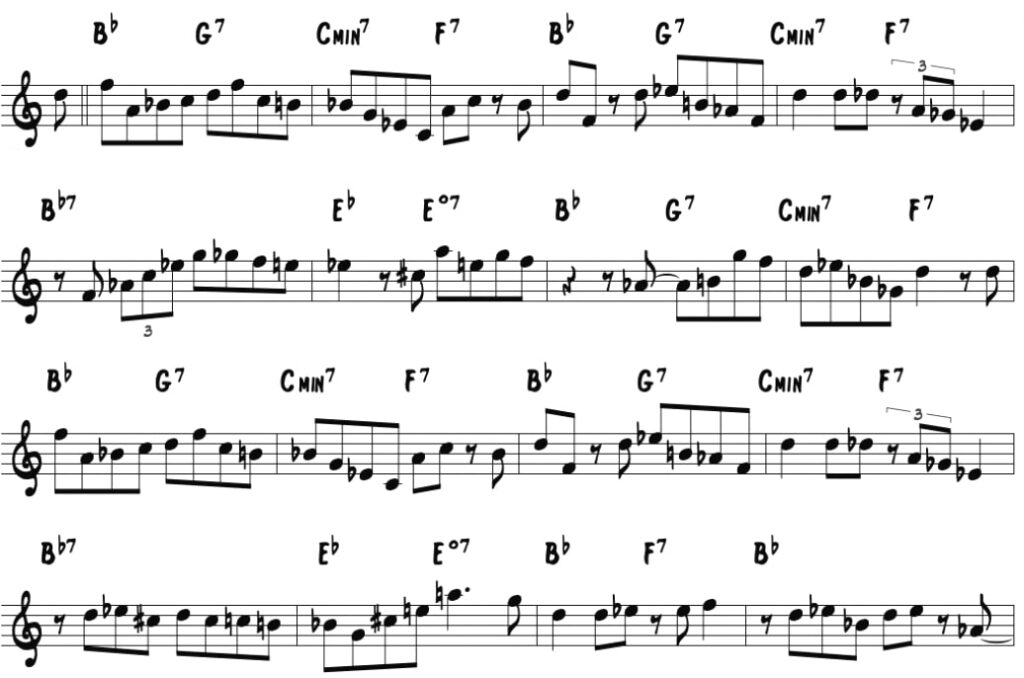
Analyzing the melody you can see how every chord of the underlying progression (I-VI-ii-V) is being addressed by the melodic line, the eighth notes lining up perfectly with the underlying chord – a hallmark of many great melodies and solos.
…but don’t get hung up on this fact too much. Focus on the sound and feel of the phrase as a whole – methodically learning the larger pieces of language, rather than trying to place individual notes or worry about scales.
Start by isolating the smaller phrases and learn a few bars at a time like the first two measures over the I-VI-ii-V progression:

Or the sequence starting in the 5th bar of I7 chord moving to the IV chord and back to I again:
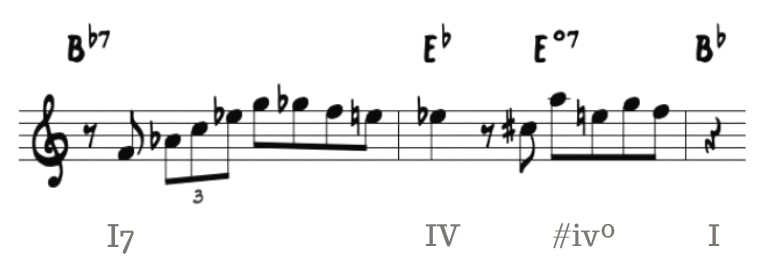
Bridge: Here the sound of the b5 or tritone is emphasized on the opening three chords of the bridge…
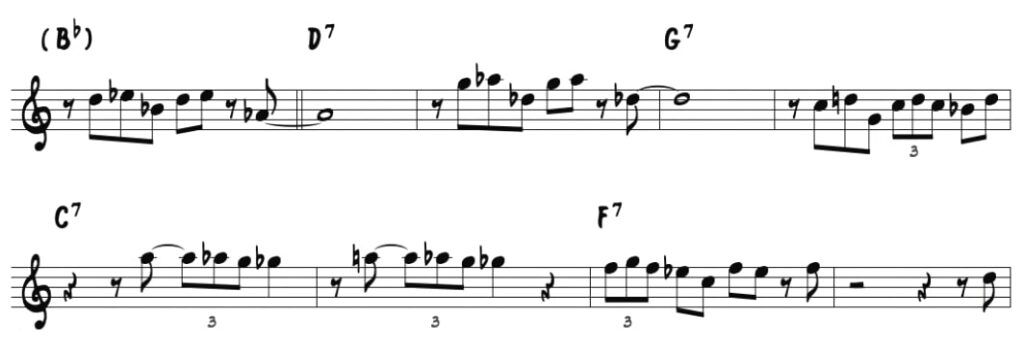
Also, on the C7 the natural 6th sound to #11 is utilized in contrast to the previous two chords.
24. Wail
Another bebop Rhythm Changes head with a long flowing melodic line and a great model for creating your own musical ideas is Bud Powell’s Wail…
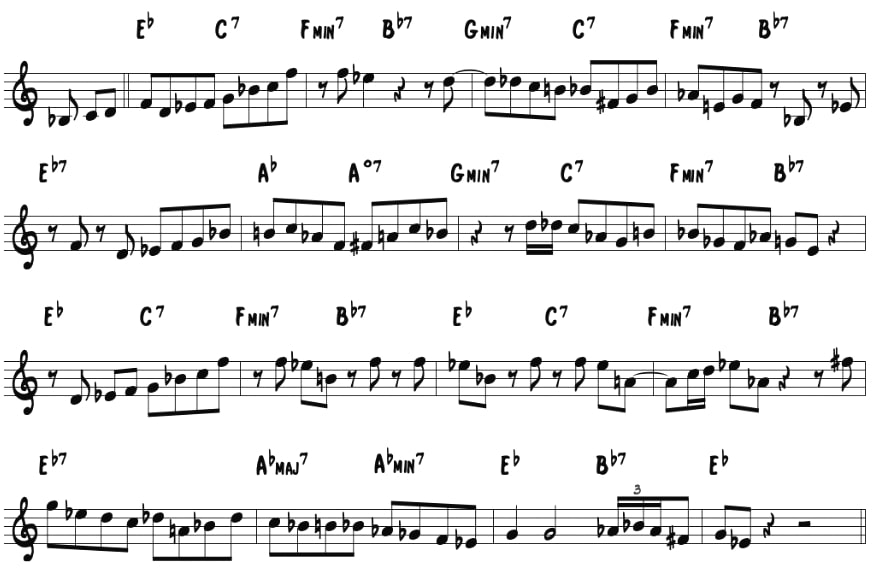
Like the last tune, it is beneficial in the learning process to break down the tune into smaller pieces, extracting phrases, language, and individual techniques to ingrain one at a time.
He approaches the first two measures (I-VI-ii-V) as the I chord, using Major language in Eb:
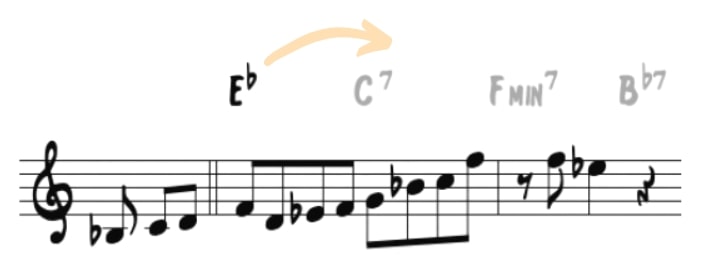
The phrase in the next two bars is also a great example of a linear approach to the iii-VI-ii-V progression…
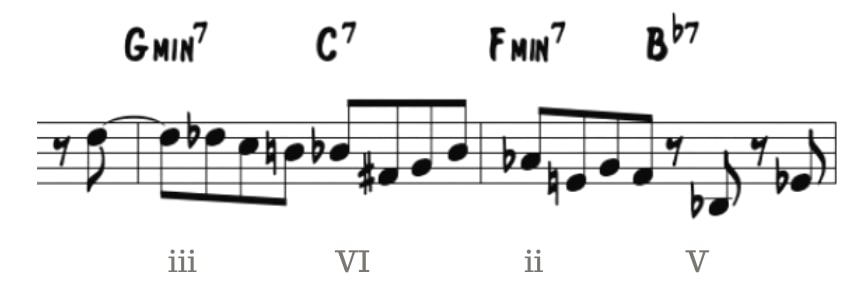
As is the line on I7 moving to IV and back to I (or iii):
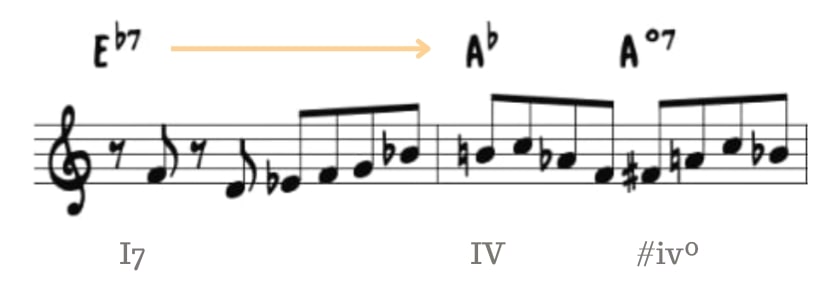
Follow the same process for the rest of the phrases in the A section, combining lines and techniques as you begin to absorb and master the musical information.
The goal is to eventually hear and play the longer phrases as one idea (4 and 8 bar segments of musical ideas).
Bridge: The bridge starts with V7 alterations like the #9 and tritone…

The line here is a sequence highlighting the sound of the #9 on the G7 and F7 chords and the sound of the #11 on the C7 and Bb7 chords.
Contrafacts
Now we’ll move onto two bebop tunes that are almost like rites of passage for any player – Donna Lee and Hot House. Complex melodies often played at up tempos that can be a challenge even for the best players.
Approach these tunes slowly at first, understanding and hearing the form. Learning the melody section by section and focusing on the technique, phrasing, articulation, etc.
25. Donna Lee
You can think of Donna Lee as a primer for bebop language and a model for creating melodic lines over the common chord movement found in the jazz repertoire.
This well know Parker composition is based on the chord progression to Indiana:
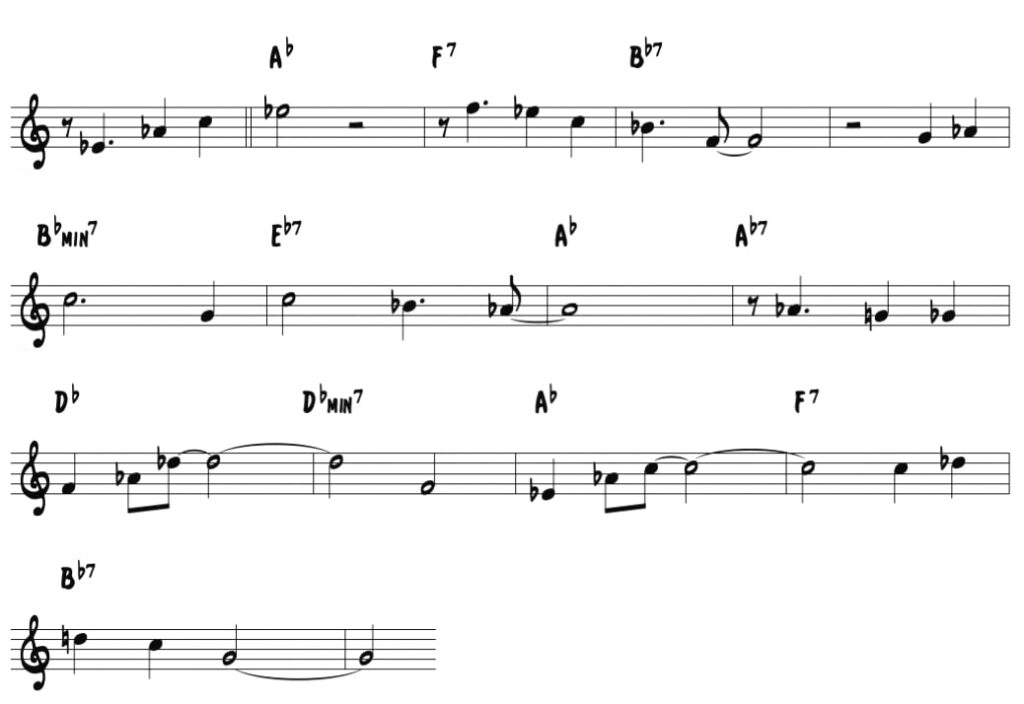
The harmonic structure here uses cycle movement in a major key, resolving around the circle of 5ths. Here you can see the overall direction of the harmony:
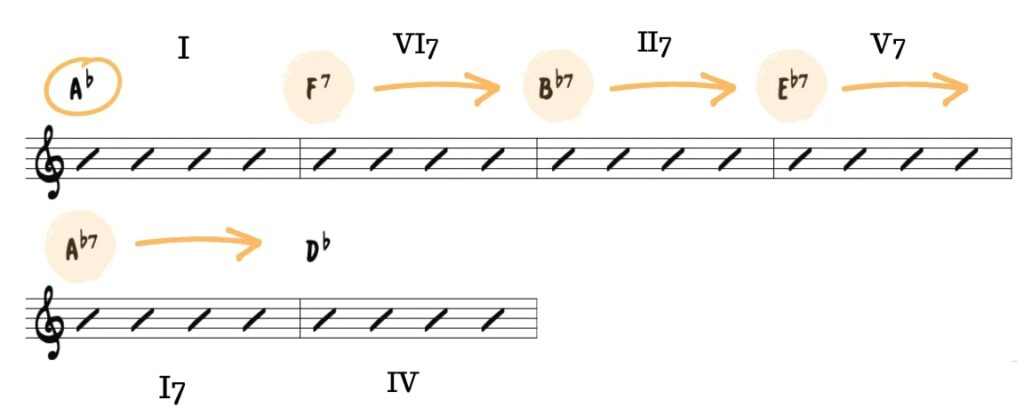
The I chord moves to the VI (F7) and then resolves around the cycle, ending on the IV chord (Db).
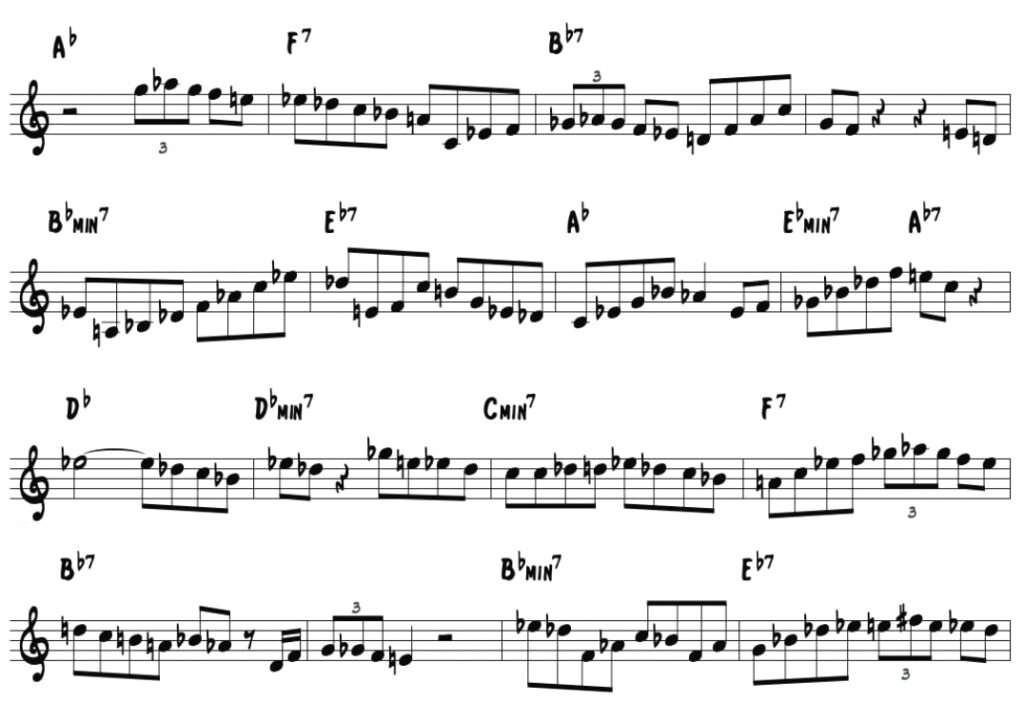
Like we did with the Rhythm Changes tunes above, your learning process will be much more effective if you isolate small pieces of each phrase and ingrain them.
As you work out each phrase, keep your eyes and ears open for the bebop tactics we highlighted in other tunes:
- Use of arpeggios
- Aiming for the 3rd of the chord
- Utilizing chromaticism, approach notes, and enclosure to create linear motion
- ii-V melodic tactics
- V7 alterations like #9, b9, #11
Start by isolating the first phrase and learning it slowly:

Look at the phrasing and melodic content within relation to the underlying harmony, in this line Bird is delaying the resolution or arrival to each successive chord by two beats:

Then move on to the 2nd phrase:

Arpeggiating the ii chord and emphasizing the #5 on the V7 chord before resolving to I. This is a great ii-V line to breakdown and slowly learn in every key.
Continue the same process with the rest of the phrases, focusing on the underlying harmony and figuring out the melodic tactics used over each chord.
Second half of tune: Parker begins the 2nd part of the tune with the same opening phrase and then transitions to the relative minor…
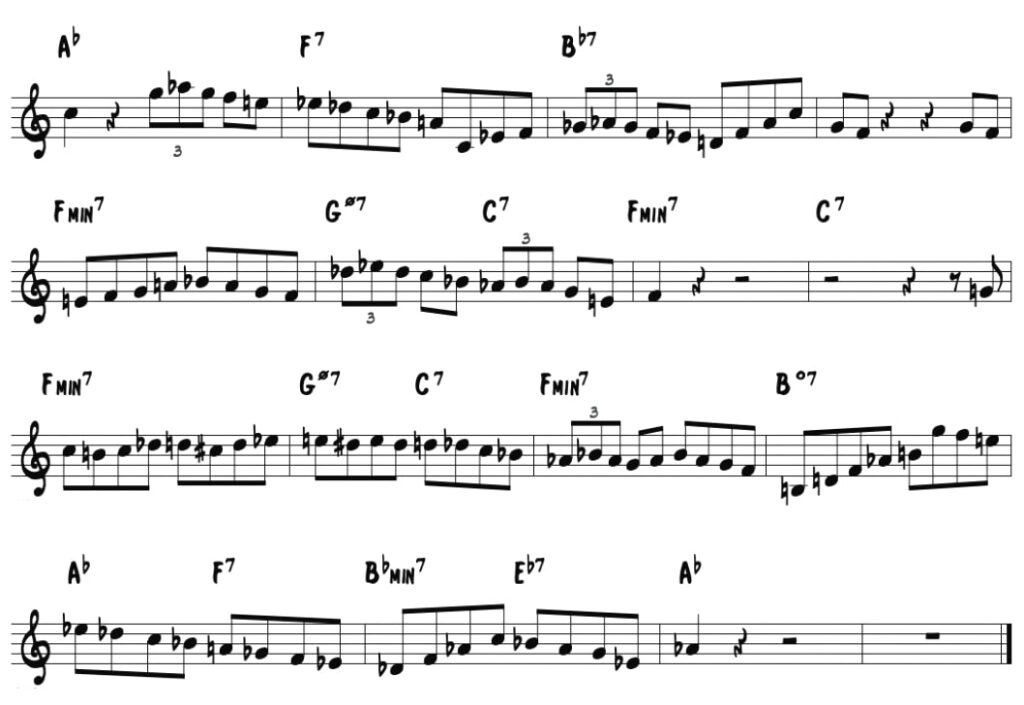
A useful line to isolate here is the i – iiø V – i in minor, taking note of V7 alterations:

Or the turnaround in the final phrase:

26. Hot House
Written over Cole Porter’s 1929 classic What Is This Thing Called Love:

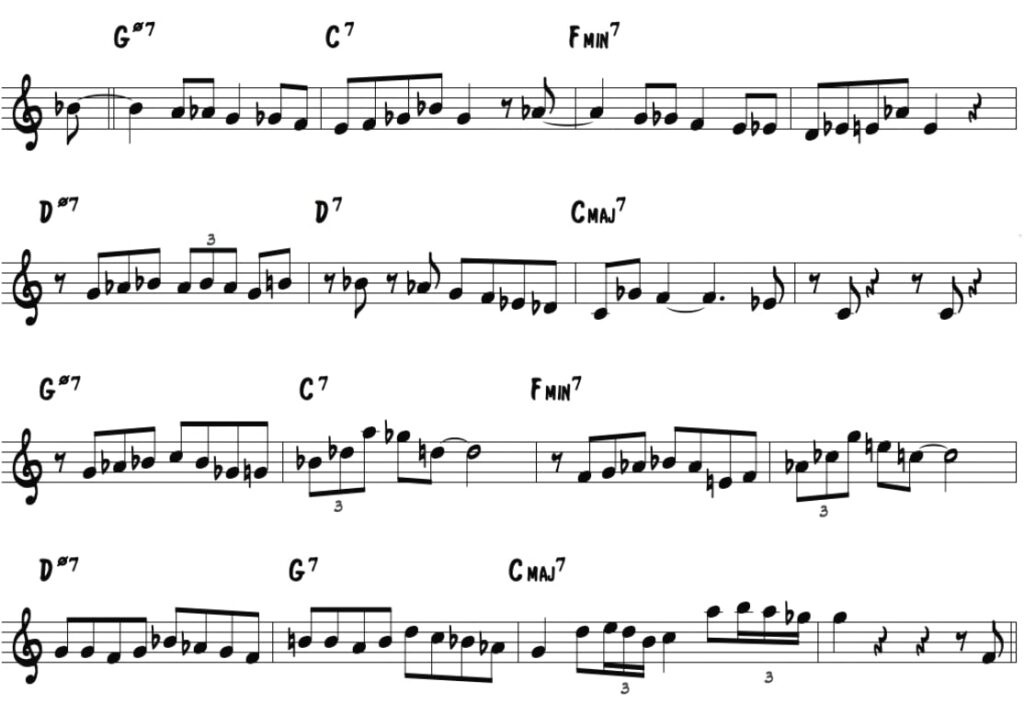
Bridge:

*Check out this lesson on Hot House for a more in-depth look at the melody and chord progression.
Original Compositions
We’ll close with four original tunes from the bebop era that feature challenging melodic, harmonic, and rhythmic elements to master in the practice room.
27. Bebop
The final minor bebop tune we’ll look at is a Dizzy Gillespie composition aptly titled …”Bebop.”
The introduction contains minor language and V7 to I motion in minor:

This line in particular over a i-V-i is an effective minor sequence to learn in all keys:

The melody is based on an ascending 3rd pattern in minor harmony, essentially outlining a i-V-i-V-i chord progression:
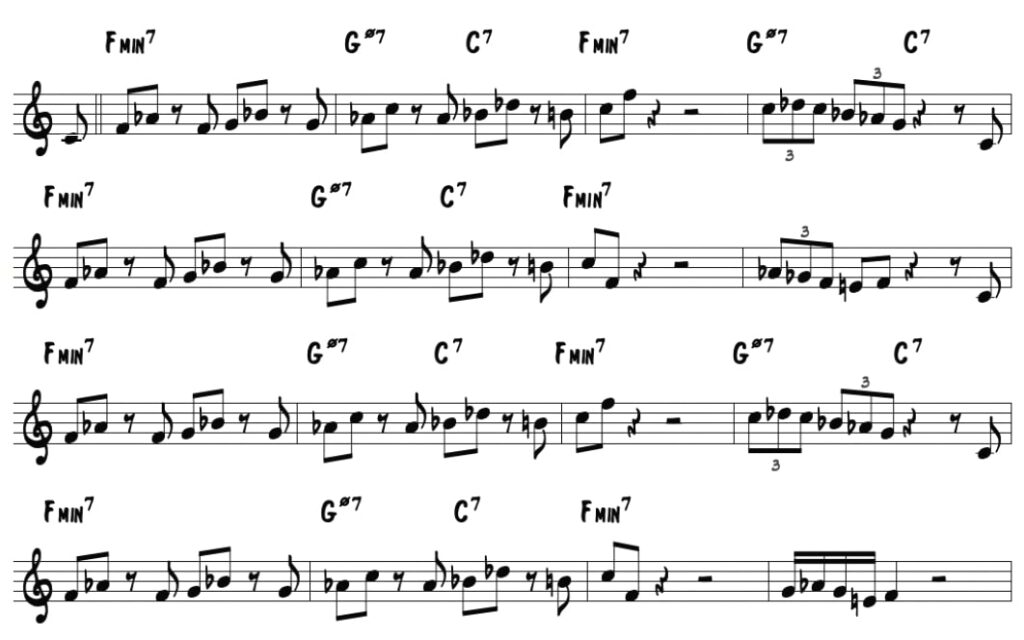
Bridge: On the bridge you’ll find a ii-V to Eb major and a ii-V down a whole step leading back to F minor…

This is another good ii-V line to learn for language and techniques:

28. Dewey Square
This 32 bar Charlie Parker tune is closely related to his other composition Yardbird Suite:
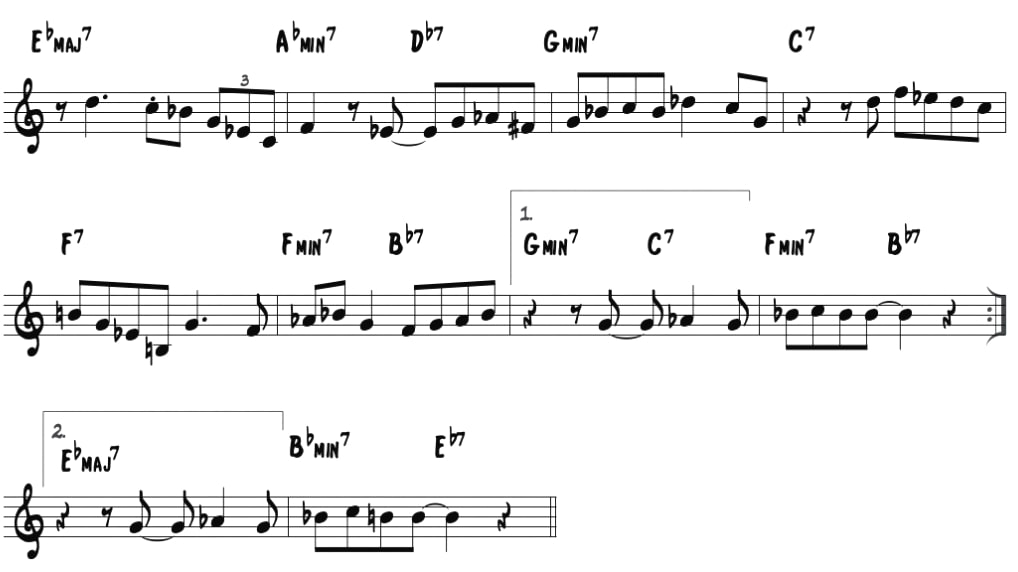
Bridge: Open/improvised
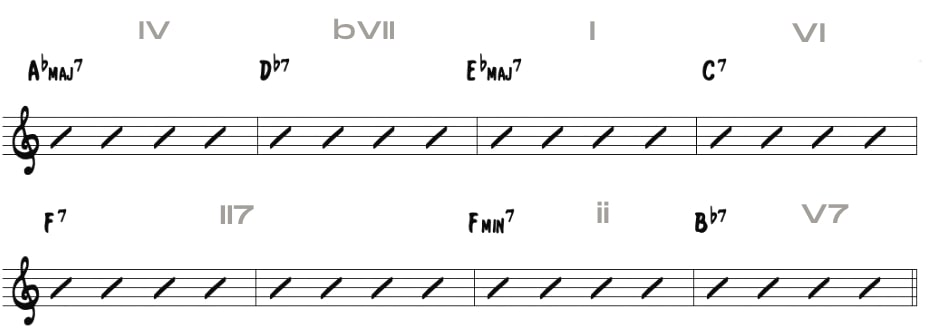
29. Ray’s Idea
Written by master bassist Ray Brown, Ray’s Idea features a Rhythm Changes A section with a bridge that contains ii-V’s descending by whole-step…
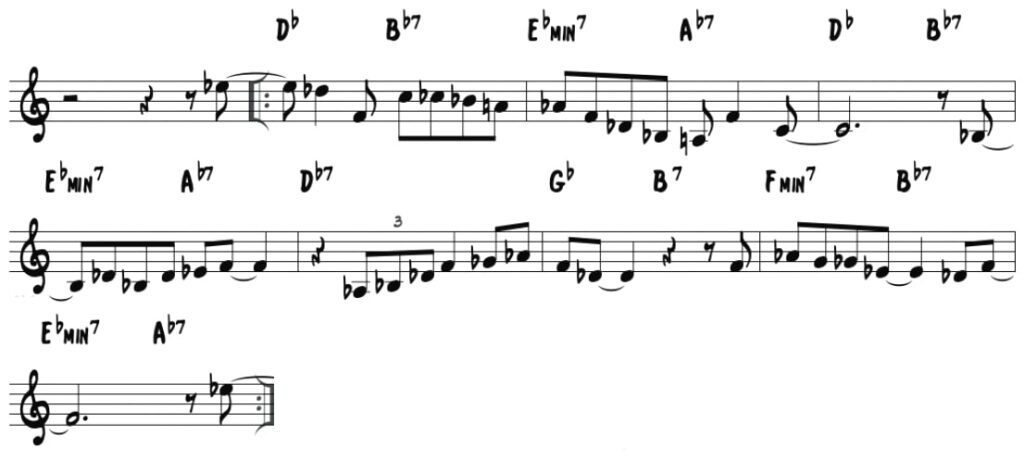
Bridge:
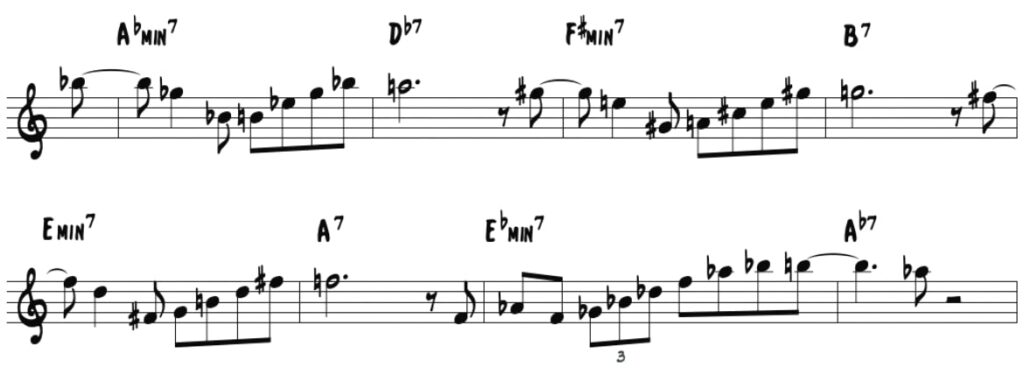
30. Boperation
The final tune we’ll look at is a Fats Navarro composition entitled Boperation…
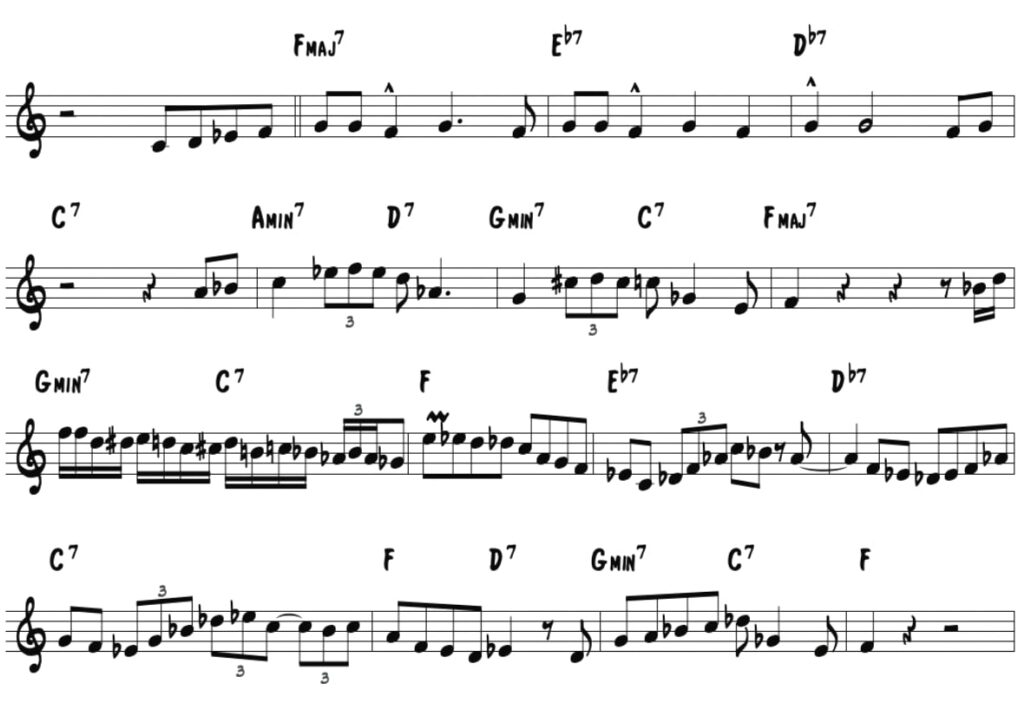
Some musical details to note on this section are:
- The I chord descending by whole-step to the V7
- A turnaround in bar 5 and a ii-V back to I
- A one measure double-time ii-V line
- The use of arpeggios to create linear material
- V7 alterations
Bridge: The progression begins with a ii-V to the IV chord, the II7 and a ii-V back to I. Here you’ll also find another tricky double-time line to navigate:
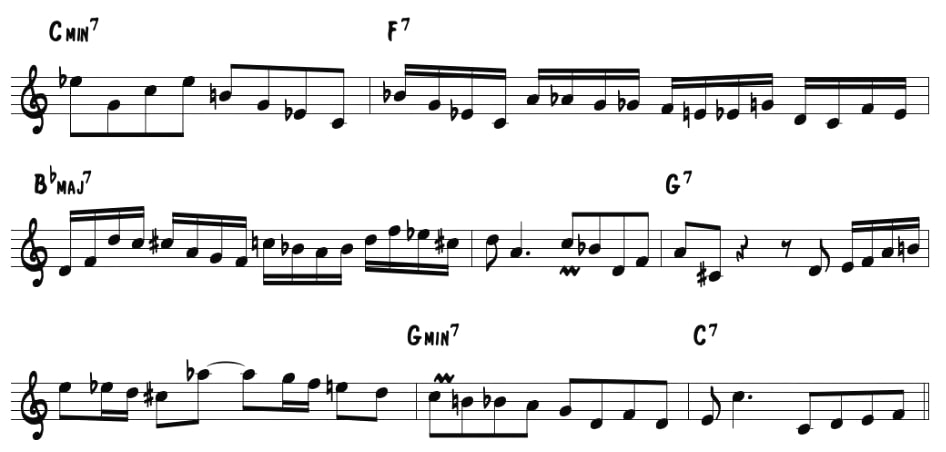
*Check out this lesson to see how Kenny Garrett improvises over the chord progression to this tune.










